PinotFile: 9.25 June 2, 2013
|
Pinot Noir Doctors
Fred W. Frailey, Editor, Kiplinger’s Although he was the most famous “Wine Doctor” and often called America’s greatest winemaker, Andre Tchelistcheff was not a licensed medical practitioner. There is, however, an extensive list of medical doctors who are winery owners, winegrowers or winemakers. In addition, there are many doctors who have combined their medical background and enjoyment of wine to become advocates of wine as part of a healthy lifestyle. Many Pinot Noir winemakers started out in a career path to become medical doctors. Examples abound, such as Dan Goldfield (Dutton-Goldfield), Natalie West (Foppiano Vineyards), Eric Hamacher (Hamacher Wines), Louisa Ponzi (Ponzi Vineyards), Melissa Burr (Stoller Family Estate), Rod Berglund (Joseph Swan Vineyards), and Cécile Lemerie-Dèrbes (Derbès Wines) According to Wine into Word (James Gabler), the first book about wine was published by Arnaldus of Villanova, who was a physician, surgeon, botanist, alchemist, philosopher, writer, astrologer, lay theologian and counselor to kins and popes. About 1310, Arnald wrote a book on wine, but because the printing press had not yet been invented, his book was initially handwritten. In 1478, his book was translated into German and printed, making it the first book on wine to use this new invention. The first complete book in English on wine was by William Turner (1568), and the first (Sir Edward Berry), the second (Robert Shannon), and third (Alexander Henderson) books in English that discuss modern wines were written by physicians. The tradition of doctors entering the wine business first began with the Australians. A procession of British ships transported convicts from Northern Europe to Australian penal colonies from the late 1700s to mid 1800s. One of those convicts was my great grandfather from Ireland, but that’s another story. The turning point in the medical treatment of convicts during transportation came in 1814, with the voyage of the Surrey. The Surrey had on board 200 male convicts, marine guards and crew. The convict’s cells below deck were poorly ventilated and not properly cleaned or fumigated. By the time the Surrey reached the East coast of Australia, the death toll from typhus was 51. Governor Macquarie ordered an inquiry into the high death toll during the voyage of the Surrey. Macquarie appointed Dr. William Redfern, Sydney’s leading doctor, also an ex-convict, to investigate. Redfern later established a vineyard in southwestern Sydney in 1818, becoming Australia’s first wine doctor. His investigations and recommendations were to have a significant influence on Australia’s wine industry. He found that the captain had withheld rations from the convicts, including their wine rations. As a result, the convicts became weak and susceptible to disease. Redfern’s recommendations included a quarter pint of wine, with added lime juice, be given to each convict every day to prevent malnutrition and scurvy. He also recommended that each transport ship have a qualified doctor on board. As a result, Australia found itself host to many naval surgeons doing convict transport. After spending six months in a leaky oak cask in the bilge of a transport ship, the wine on board was frequently oxidized and contaminated with sea water. As a result, many doctors that had retired to Australia established vineyards to avoid problems associated with transporting wine to Australia as well as to provide wine as a medicine for their patients. Australia is now unique among wine producing countries in that 60% of the fruit from any vintage is processed by wine companies established by Australia’s over 160 wine doctors. Australia’s three largest wine companies, Lindemans, Penfolds and Hardys, for example, were all founded by doctors as were other famous Australian labels such as Angoves, Stanley and Houghton. One modern Sydney physician and wine historian, Dr. Phillip Norrie, founded The Wine Doctor Label, and produces wines with enhanced resveratrol content. The Australians should consider replacing the medical profession’s traditional symbol of a snake caduceus with a glass of wine and a convict’s leg iron. I have often contemplated the reasons for the strong connection between medical doctors and wine, and I find there are considerable parallels for such an association. A physician is typically intelligent, inquisitive, dedicated, prestige-driven, and goal oriented, all of which are qualities that lend themselves to success in winegrowing, winemaking and the wine business. The complexity of wine, like the complexity of the human body is fascinating to medical practitioners. Physicians learn the life sciences and biochemistry in training that are the backbone of winegrowing and winemaking and make the transition to vinifying wine a natural step, and the many principles employed in the treatment of human disease can be applied to treating grapevine disease. Medicine is constantly changing requiring doctors to keep up with new developments, much like the fields of viticulture and winemaking. Medical doctors often have the spendable income that allows them to indulge their interests as well. Since doctors spend so much time indoors in their office and hospital, the chance to work outdoors offers a peaceful way to balance out their day to day activities. In addition, grapevines, unlike patients, don’t complain. Both medicine and winemaking are fields that uniquely combine art and science. Some have said that winemaking, and even practicing medicine is more a craft than an art, but I believe there is some artistic component to the winemaking process and most definitely some truth to the proverbial “art of practicing medicine.” The best doctors and winemakers know when to wait and when to do nothing. They both realize that a long night spent at a crucial time can potentially avoid an undesirable result. This quote from Keith Marton, M.D. in the Stanford alumni magazine, Bench & Bedside, about why people in medicine are drawn to wine is well put. ”It’s the right confluence of art and science that doctors appreciate. If you look around and see how doctors lead their lives, you will find what I would call an aesthetically prone group of people who also are scientists at heart. Not only are doctors often interested in wine, they’re also interested in music and art. Many of the doctors I know have a strong aesthetic sense that wine really satisfies.” Most doctors find that they learned about wine without formal training, using the advice of winegrowers and winemakers, reading books, and taking courses from colleges and college extension programs. I asked a number of “Pinot Noir Doctors” to share their story of how they became interested in wine, what drove them to enter the wine business, and why they thought physicians were drawn to wine. My research uncovered a surprisingly large number of “Pinot Noir Doctors” in California and Oregon, many of whom contributed their stories in the pages to follow. The “Pinot Noir Doctors” were overwhelmingly male. Although it has been reported that second career vintners will fail 60% of the time and won’t see profit for at least seven and more likely ten years, none of the wineries profiled here have failed because of financial reasons. Curiously, a majority of the doctors prefer to stay out of the limelight and are quite humble about their accomplishments. Thirty-seven “Pinot Noir Doctors” are profiled here, but if you know of others worth mention, please let me know their details. I did not include medical doctors who were winery owners, vineyard owners or winemakers whose major focus is varietals other than Pinot Noir, but some of their names bear mention:
In California:
Ernest A. Bates, M.D., Black Coyote
In Oregon: H. Earl Jones, M.D., Abacela Vineyards & Winery Elsewhere in the United States:
Bryan Staffin, M.D., Fox Hollow Vineyards, Lake Michigan Shore, Buchanan, Michigan
International: Laura Catena, M.D., is a fourth generation Argentine vintner who graduated from Harvard University in 1988 and received her Medical Doctor degree from Stanford University. She is currently general director of Bodega Catena Zapata and her own Luca Winery in Mendoza, Argentina, as well as a practicing Emergency Medicine physician at University of California San Francisco Medical Center in California. She is the “face” of Argentine wine for her active role in promoting the Mendoza wine region. Max Heger, M.D., a country doctor in Ihringen, Germany, with patients throughout the Kaiserstuhl area, was also a former bee keeper and pigeon breeder who entered the wine business in 1935 by accumulating portions of Voederer Winklerberg, today the 18 acres of Ihringer Winklerberg, the foundation of the Dr. Heger Estate. In 1949, his son Wolfgang began to build a reputation for the estate. For their accomplishments both Dr. Heger and Wolfgang Heger received the distinguished service cross from the German government. Julio Palmaz, M.D. invented the Palmaz Coronary Stent, the heart stent that was eventually licensed to Johnson & Johnson. While completing his residency at University of California at Davis, his passion for wine began. Along with his spouse, Amalia, and family, he moved from his native Argentina to the San Francisco Bay area and became enchanted with the Napa Valley. He established Palmaz Vineyards in the Napa Valley in 1997, on the site of Cedar Knoll Vineyard and Winery that had been founded in 1881 by Henry Hagen, one of Napa Valley’s pioneer winemakers. With his interest in mechanics and engineering, he played an integral role in designing Palmaz Vineyards’ gravity flow winery. Philip Norrie, M.D. is a winemaker and general practice doctor in Australia who has written eight books on wine and health. He continues the long Australian tradition of winemaking doctors. His winery, Pendarves Estate, is located in the lower Hunter Valley. With 30 acres of vines, the estate produces a range of varietal wines. Justin Peter Ardill, M.D., an interventional cardiologist, is the joint founder with wife Julie, and winemaker for Reilly's Wines in Clare Valley, South Australia. Reilly Wines produces 7,000 cases of Shiraz, Cabernet Sauvignon, Grenache blend and Riesling from estate vineyards dating back to 1919. The wines have received numerous awards both domestically and internationally.
California Pinot Noir Doctors
F. Wells Shoemaker, M.D.
Medical School: Stanford University School of Medicine
Dr. Bruce is an iconic winemaker whose combination of scientific curiosity and passion led him to become one of the first to produce credible Pinot Noir in California. Although he is now 83 years old and no longer involved to a significant degree in the winery, his legacy is firmly established. I last saw him at both the 2009 World of Pinot Noir and the 2009 Pinot Noir Summit where he was said to be organizing his memoirs for inclusion in a book about his extraordinary career. Mark Greenspan (Wine Business Monthly June 2011), who worked with Bruce’s vineyards since 2006, found him still active, serving as executive winemaker, and holding weekly tastings with his staff. Greenspan said, “David Bruce did Pinot before Pinot was cool.”
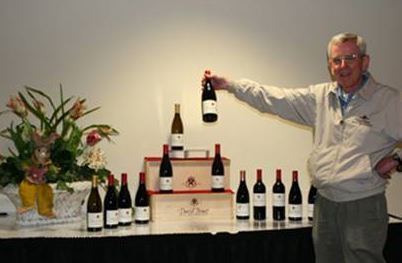 Born in San Francisco, he was said to have his wine epiphany while attending medical school when he bought a bottle of 1954 Richebourg that cost him a large sum for the time - $7.50. He became inspired by the book Wines of France by Alexis Lichine, and intrigued with the Pinot Noirs made in the Santa Cruz Mountains by Martin Ray. John Haeger (North American Pinot Noir 2004) notes that Bruce considered Ray’s Pinot Noirs better than those of Domaine de la Romanée-Conti. While in Oregon for his residency, he was said to have made wine, and considered staying there to establish a winery. This was about the time Richard Sommer traveled to the Umpqua Valley from California and planted the first post-Prohibition Vitis vinifera including Pinot Noir in Oregon in 1961. The lure of the Santa Cruz Mountains won out. He bought 40 acres there in 1961, coinciding with the start of his dermatology practice in Los Gatos. He cleared the land and planted 25 acres of vines by hand including Pinot Noir in 1962. A winery was built on the site, which was bonded in 1964. The first commercial release of David Bruce Winery Pinot Noir came in 1966. Dr. Bruce bought another vineyard in the Vine Hill subregion of the Santa Cruz Mountains in 1968 that was formerly owned by the Pesenti-Locatelli family. He pulled out the Zinfandel planted there and replanted the vineyard to the Wente clone of Pinot Noir on its own roots. Ken Burnap, a restaurateur from Southern California was impressed with the Pinot Noir produced from Bruce’s vineyard, and bought Bruce’s 26-acre vineyard in 1974, renaming it Santa Cruz Mountain Vineyard. Dr. Bruce was an innovator who traveled frequently to Burgundy and became one of the first California winemakers to use whole berry fermentation and whole clusters for Pinot Noir, and to advocate foot crushing of the cap, the use of rotary presses, extensive skin contact, and small barrel French oak fermentation. Bruce’s early Pinot Noir wines were uneven and he was to say, “Pinot Noir is the Dune of winemaking,” referencing the science fiction novel. He had well-chronicled challenging problems with cork taint ( his cork disaster in 1987 cost him $2 million in lost business according to George Tabor writing in To Cork or Not to Cork) and Brettanomyces, but his Pinot Noir wines eventually achieved widespread acclaim by the 1980s. By then, he easily sold out the 30,000 cases of wine he produced. He was one of the first California winemakers to produce a Blanc de Noir, a white Zinfandel, and late harvest wines, and became known for Petite Sirah as well. Early on, he was most known for Chardonnay, and his 1973 Santa Cruz Mountains Chardonnay was one of twelve California entries to participate in the famous 1976 “Judgment of Paris.” One of Dr. Bruce’s legacies will be the “David Bruce Clone” of Pinot Noir that was discussed previously in detail in the PinotFile: www.princeofpinot.com/article/1223/. Cuttings from David Bruce’s vineyards have been distributed throughout California. For 25 years, Dr. Bruce practiced dermatology while making wine at night and on the weekends, eventually deciding to devote himself completely to winemaking in 1985. Because of his medical background, Dr. Bruce was also one of the first to extoll the health virtues of drinking wine years before the 1991 appearance of the 60 Minutes television program on the French Paradox. He published a booklet titled, Ten Little Known Medical Facts About Wine That You Should Know.” He was one of the first doctors to publicize that resveratrol in red wine increases good cholesterol and reduces bad cholesterol. He recommended that hospitals have wine on the patient menus, and encouraged a glass of wine for the elderly to improve their appetite and raise their self esteem. He also defused the hysteria about sulfite allergies to wine and elevated lead levels in wine. Today, the 16-acre Estate Vineyard, located at 2,200 feet in the Santa Cruz Mountains, has 9 acres planted to Pinot Noir and the rest to Chardonnay in addition to a recently planted block of Riesling. The original plantings were destroyed by Pierce’s disease by 1992, and the Estate Pinot Noir program was resumed in 1996 when new plantings reached maturity. The new plantings came from budwood from the nearby Noble Hill Vineyard that had been planted in the 1980s with cuttings from the original Estate Vineyard plus several other clones. The winery sources grapes from over thirty growers throughout California representing ten different appellations. The Estate Pinot Noir is the signature wine in the David Bruce lineup, but of the 60,000+ case annual production, most of the Pinot Noir over the last decade has been pretty ordinary appellation-designated Pinot Noir. Some limited production vineyard-designated wines are offered in the tasting room on Bear Creek Road which is open daily. The website at www.davidbrucewinery.com is woefully outdated with the Pinot Noir releases listed from the 2000 vintage. For more historical information on David Bruce, consult The David Bruce Winery: Experimentation, Dedication and Success, from the Regional Oral History Office, The Bancroft Library, University of California, Berkeley at www.archive.org/details/davidbrucewinery00brucrich. Some of the information I have included here should be credited to this source. A reliable history of the winery is also detailed in John Haeger’s North American Pinot Noir (2004).
2009 David Bruce Appellation Series Russian River Valley Pinot Noir 14.7% alc., $40. · Dark reddishpurple color in the glass. Aromas of black cherries, black currants, cola and bark. Very ripe and sweet flavors of dark fruits with a hint of cola. Dense and plush with balanced tannins and acidity, leaving a touch of heat behind on the finish. Decent.
2010 David Bruce Appellation Series Sonoma Coast Pinot Noir 14.7% alc., $40. · Moderately light reddishpurple color in the glass. Raisin-toned fruit aromas with notes of dark chocolate and oak. Very ripe black cherry and black raspberry flavor with svelte tannins and a good cut of acidity on the finish. A mainstream Pinot that became less attractive over time in the glass. Decent.
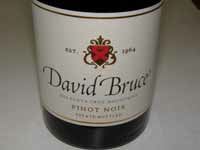 2002 David Bruce Estate Santa Cruz Mountains Pinot Noir 14.1% alc., $55. Estate vineyard. Unfined and unfiltered. · Moderately dark reddish-purple with slight bricking of the rim in the glass. Lovely bouquet of an aged wine including old book, vitamin, tobacco and old wood. Satisfying flavors of black cherries and sassafras backed by firm, grainy tannins. The fruit is still alive and vivid. Drink up. Very good.
2007 David Bruce Estate Santa Cruz Mountains Pinot Noir 14.7% alc., $55. Estate vineyard. Unfined and unfiltered. · Moderately dark reddish-purple color in the glass. Shy aromas of black cherries, berries and oak. Mid weight red fruit core with good intensity. Soft in the mouth and firmly structured with muscular dry tannins, finishing powerfully but with a little heat. The tannins tend to overpower the fruit. Good.
Medical School: St. Louis University School of Medicine 1971
Dr. Compagno is the owner and Medical Director of West Coast Pathological Laboratories in Hercules, California, a company first established in 1985. He has been practicing medicine since 1971 and pathology since 1974, and has authored several peer reviewed publications on pathology.
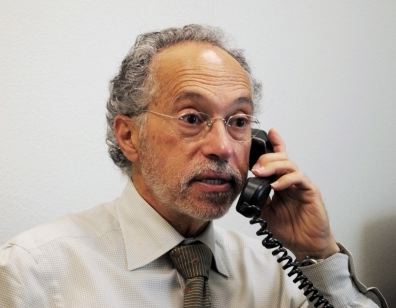 While living in Napa, Dr. Campagno wanted some insight into the wine industry and began taking evening classes on viticulture and enology at Napa Valley College while working his day job as a pathologist. While taking classes, he contacted a young realtor to assist him in finding property. The realtor suggested he take at look at the 5-acre Carneros Vineyard planted to Pinot Noir belonging to Gary Andrus who owned Gypsy Dancer Estates at the time. He considered the vineyard workable if he did the farming and bought it in 2006. One of the conditions of sale was that Gary Andrus would take him on as an apprentice for three years but it was a tumultuous time for Andrus and the apprenticeship never developed. Gary Andrus passed away in 2008. The vineyard had been neglected and served as a challenge. The realtor’s young husband was a vineyard manager at Saintsbury Vineyard, about 100 yards from the property, and he offered to be his vineyard consultant. He ended up being a great resource. To this day, Dr. Compagno is involved in the vineyards directly and hands on from harvest to barreling when possible. He farms the Carneros vineyard, usually on weekends, with occasional help from a crew from Pine Ridge Winery, another former property owned by Gary Andrus. An employee and contracted crew take care of the vineyard in the Willamette Valley. Dr. Compagno is also the winemaker and Gail, his business partner, helps with winemaking and blending decisions. Once Gary Andrus and others gave him the principles of winemaking, it has been a matter of “on the job” production and learning. Dr. Compagno also bought Gypsy Dancer Estates in the Chehalem Mountains from Gary and Christine Andrus in 2008 and renamed it Árdiri Winery & Vineyards. Árdiri means “taking a risk” in Sicilian. The property consists of 13.5 acres of Pinot Noir, Pinot Blanc and Pinot Gris. A tasting room was added to the property that is open on Friday, Saturday and Sunday and Wednesday and Thursday by appointment. Dr. Compagno produces Pinot Noir from both Carneros and Oregon, as well as a blend of grapes from the two regions labeled “Due Stati.” The website is www.ardiriwine.com. When asked why physicians are attracted to the wine business, he told me the following. “I suspect that there is a certain aura about wine, the history, the international character, the global business, as well as the perception that it is an easy entry with an inherent charm. A touch of arrogance doesn’t hurt. In my case, I have a background in chemistry and microbiology, perfect for understanding the procedures and principles. Many of my associates over the years have assumed that it is just a hobby with me. However, it is not. It is both an avocation and a business, and I receive great satisfaction when someone enjoys my wines so there is creativity at work here as well.”
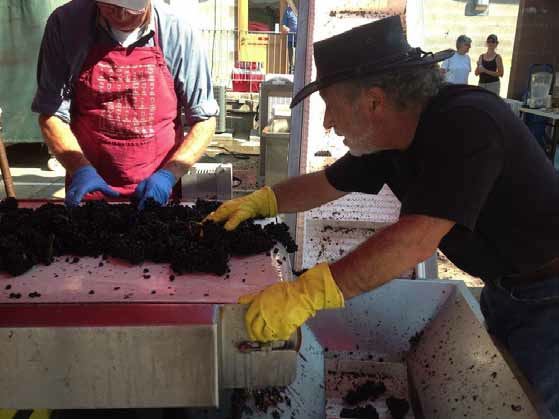
2011 Árdiri Pink Tractor Willamette Valley Rosé 12.7% alc., 75 cases, $N/A. Estate grown. 50% whole cluster, fermented at cool temperatures. · Delicate pink-orange color in the glass. Very nice aromas of tangerine and golden apple. Bright and crisp, with flavors of strawberries, blood oranges and tangerines. Very easy to cozy up to and about as pleasurable as rosé gets. Very good.
2009 Árdiri Vineyard Select Chehalem Mountains Willamette Valley Pinot Noir 15.5% alc., $29. · Medium reddish-purple color in the glass. Not particular expressive nose with delicate aromas of very ripe black fruits and oak. Unusual heft and ripeness for Oregon although 2009 was a warm vintage. Flavors of black plum reduction sauce, blackberry jam and black tea with muscular tannins in the background. Too ripe for my taste. Decent.
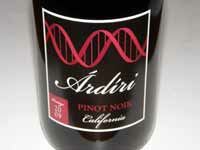 2009 Árdiri California Pinot Noir 14.7% alc., 640 cases, $29. Sourced from the estate Carneros vineyard and includes clones 828, 777, 667, 115 and heirloom selections. Moderately light reddishpurple color in the glass. Fragrant with · Moderately light reddishpurple color in the glass. Fragrant with aromas of dark cherries, strawberries and sandalwood. Very enjoyable with refreshing flavors of dark red cherries and berries brown baking spices, supported by modest fine-grain tannins. Very smooth and easy to like. Very good.
2009 Árdiri Due Stati Oregon/California Pinot Noir 14.5% alc., $N/A. “Two states.” Produced from seven clones, aged 18 months in French oak and barrel selected. · Moderate reddish-purple color in the glass. Shy aromas of slightly roasted black fruits, brewed tea and oak. Flavors of dark berries and plum that veer to the ripe side with a hint of carmelized oak. Good mid palate intensity and follow through on the finish with balanced tannins. Chehalem Mountains fruit dominates the flavor and stylistic profile. Good.
Medical School: Yale University Medical School 1988
Dr. Cutruzzola (“koo-troot-ZOL-a”) is a practicing radiologist in Santa Rosa, California, at Sutter Medical Center and Santa Rosa Memorial Hospital. He became interested in wine in medical school and still fondly recalls a bottle of Vosne-Romanée he enjoyed on his shoestring budget at the time. He noted, “It took half the bottle to realize how great the wine was, and the second half was gone before I knew it.” Unfortunately, he has no idea of the producer or vintage, but that bottle left him with a thirst for Pinot Noir. Several years later, he moved to California with a notion to buy land and grow Pinot Noir. In 2000, he found a suitable property for sale seven miles east of the town of Cambria on California’s Central Coast that he considered an ideal cool climate site for Pinot Noir. He planted the first five acres of Pinot Noir there in 2001. Unfortunately, he unexpectedly ran out of water, and four of the five acres died. He replanted the Pinot Noir in 2006 and 2007 (clones 667, 828, 115, 23 and Pommard 5), adding two acres of Riesling, with the assistance of vineyard manager Bill Kesselring. Kesselring advised him to drop all the fruit in 2007 and let the vines strengthen. Cutruzzola took a small crop in 2008 consisting of 5 tons of Pinot Noir and 1 ton of Riesling, and made the wines at home. 2009 yielded enough quality grapes to launch the Cutruzzola Vineyards label. Kesselring introduced Cutruzzola to Steve Dooley of Stephen Ross Winery who assisted him in making the wines. Cutruzzola believes many physicians are drawn to the wine business because “medicine, viticulture and winemaking are all complex subjects with numerous variables, and these fields attract curious people who love learning.” Cutruzzola Vineyards offers both a Riesling (Riven Rock Vineyard) and Pinot Noir (Gloria) that are sold through a mailing list and the winery’s website store at www.cutruzzolavineyards.com.
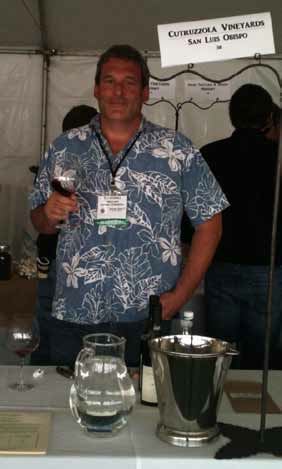
2010 Cutruzzola Vineyards Gloria San Luis Obispo County Pinot Noir 14.4% alc., $34 (by the case). · Moderately dark reddish-purple color in the glass. Strutting aromas of red cherries, fruit leather, sandalwood and rose petals. Delicious flavors of boysenberry and black cherry cola complimented by cardamom spice. The cherry really sings in this wine on the relatively long finish. Nicely balanced and ready for prime time now. Very good.
Undergraduate: Xavier University, Biology 1956
Dr. Fogarty was born in Cincinnati, Ohio, into a poor, Iris Catholic family. He was naturally inquisitive as a youngster and was good at building and repairing things. His original career choice was to be a boxer, but his early work experience which began as a fourteen-year-old at Good Samaritan Hostpital was to spark his interest in becoming a doctor. His boxing career was put aside when he broke his nose in a match at the age of seventeen at a time he had become increasingly inspired by his work as a surgical scrub technician. Dr. Fogarty was fortunate to have a mentor in Dr. Jack Cranley, one of the most prominent vascular surgeons in the United States. He had assisted Dr. Cranley at Good Samaritan Hospital and Dr. Cranley encouraged him to go to college. Dr. Cranley was also to provide financial assistance for Fogarty to attend college. While at Good Samaritan Hospital, Dr. Fogarty observed that many patients died from complications of blood clot surgeries. The arteries had to be surgically opened to remove the clots, a lengthy and risky procedure that resulted in fifty percent of the patients dying from complications. He devised a catheter that could remove clots with minimal intervention in 1961 while an intern at the University of Oregon Medical School in Portland, Oregon. For years he could not find a company to manufacture the device so he began making the embolic catheter system himself and published a scientific article on it in 1963 while serving his surgical residency in Portland. In 1969, Dr. Fogarty patented the device and Edwards Life Sciences in Irvine, California, began manufacturing the Fogarty balloon embolectomy catheter. Today, it is the still the standard for blood clot removal. Dr. Fogarty has more than 100 other surgical patents. He left Stanford Medical School after fourteen years as a professor and practicing cardiovascular surgeon, and in 2007 founded the Thomas Fogarty Institute for Innovation on the campus of El Camino Hospital. The educational, non-profit organization mentors medical innovators. He has been the founder or co-founder and chairman of the board of more than 33 business and research companies based on devices designed and developed by Fogarty Engineering Inc. located near Stanford University in Portola Valley. In 2001, he was inducted into the National Inventors Hall of Fame.
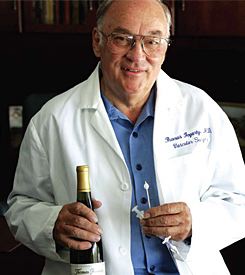 Dr. Fogarty was training in Oregon when he discovered the pleasures of a wine and in particular, a dry Gewürztraminer. In 1969, when he began teaching cardiovascular surgery at Stanford University Medical Center, he was introduced to the wine industry while helping out a colleague with his small vineyard and winery. He soon began making wine at the facility himself. With the profit gained from the sales of his embolectomy catheter, in the early 1970s he bought 325 acres of land at 2,000 feet elevation on Skyline Drive in the Santa Cruz Mountains town of Woodside. His initial 3-acre plantings in 1978 were the first in the region’s Skyline Ridge. Dr. Fogarty met winemaker Michael Martella in 1980 when Martella was working at a large winemaking facility in the Central Valley of California. The two quickly became friends, Martella was hired, and he has been the winemaker ever since the first wines were released from the 1981 vintage. Martella assisted Dr. Fogarty in planning a winery and developing estate vineyards. Two vineyards were planted in 1981 with heritage selection cuttings from David Bruce and Martini. The higher 2-acre vineyard at 2,000 feet was named Langley Hill, while the larger, less elevated vineyard of four acres became Rapley Trail. The first vintage from the estate vineyards was in 1986. The estate vineyards now total 40 acres, 10 of which are planted to Pinot Noir (Windy Hill which was pulled out and replanted after the 2011 vintage, Razorback and Rapley Trail, and Langley Hill which is now all Chardonnay, and Chardonnay vineyards that include Damiana, Portola Springs and Albutom). All estate vineyards are low yielding (1 to 3 tons per acre). The Thomas Fogarty Pinot Noirs are now among the finest produced from the Santa Cruz Mountains AVA and include a Santa Cruz Mountains bottling (from estate and sourced fruit), and vineyard designates from Windy Hill and Rapley Trail vineyards, and in some vintages, two block designates from Rapley Trail, “B” Block and “M’ Block. Dijon clones sourced from other Santa Cruz Mountains vineyards have been blended into the estate wines. Since 2004, University of California at Fresno graduate Nathan Kindler has shared the winemaking duties, brought a new prospective to the wines, and has become the winemaking and marketing face of the winery. The Pinot Noirs, which originally were full-bodied, intensely flavored and highly tannic, are now produced with less extraction, more restrained tannins and better balance. All Pinot Noirs are fermented in small lots with 25% to 50% whole cluster and ambient yeast fermentations. The wines are aged in 3-year air-dried, tight-grain French oak barrels. The Thomas Fogarty Winery tasting room is open Monday 11:00 to 4:00 and Wednesday through Sunday from 11:00 to 5:30. The setting has breathtaking views of the entire Silicon Valley below. The site is popular for weddings and corporate events and a separate facility has been set aside for these activities. The wines are sold on the website at www.fogartywinery.com. Among the several varietals offered, a Gewürztraminer, the wine that sparked Dr. Fogarty’s interest in wine, is offered made from grapes grown in Monterey County.
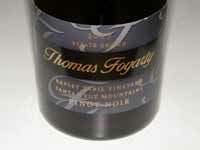 2007 Thomas Fogarty Rapley Trail Vineyard Santa Cruz Mountains Pinot Noir 14.5% alc., 125 cases, $48. · Moderate reddish-purple color in the glass. Great nose! Vibrant aromas of dark cherries, dark red berries and spice. Delicious core of black cherry, black currant, cola and anise flavors with an earthy and mineral-driven iron bent. Admirable balance and easy drinkability with considerable length on the fruit-packed finish. Impressive.
2007 Thomas Fogarty Rapley Trail Vineyard Block B Santa Cruz Mountains Pinot Noir 13.8% alc., <50 cases, $68. · Moderately dark reddish-purple color in the glass. The nose unfolds beautifully over time in the glass to reveal aromas of chocolate cherry cake, leather hide, and cardamom spice. Vibrant flavors of dark cherries and dark red berries with complimentary hints of black licorice and Harissa. There is definitely a minerality component to this wine as it tastes of the soil. Good richness and well balanced supporting tannins. A complete wine of uncommon breeding.
2010 Thomas Fogarty Santa Cruz Mountains Pinot Noir 14.0% alc., pH 3.8, TA 0.57, 1,514 cases, $35. Aged 10 months in 20% new French oak barrels. · Medium reddish-purple color in the glass. Brightly perfumed with aromas of cherries, spice, briar and tea. Tasty array of redder fruit flavors including ripe strawberry, black cherry and raspberry with a hint of curry spice. Refreshing with lively acidity and complimentary oak with mild dry tannins and a soft texture. A solid drinker. Good (+).
2010 Thomas Fogarty Rapley Trail Estate Vineyard Santa Cruz Mountains Pinot Noir 14.3% alc., pH 3.80, TA 0.61, 261 cases, $55. No block bottlings in 2010 so all the best fruit from the “B” and “M” block are included. Aged 10 months in 40% new French oak and bottled unfiltered. · Moderate reddishpurple color in the glass. Great nose! Vibrant aromas of dark cherries, dark red berries and spice. Delicious core of black cherry, black currant, cola and anise flavors with an earthy and mineral-driven iron bent. Admirable balance and easy drinkability with considerable length on the fruit-packed finish. Impressive.
2010 Thomas Fogarty Windy Hills Vineyard Santa Cruz Mountains Pinot Noir 13.6% alc., $N/A ( sold out).A hilltop vineyard in the skyline sub-region at 2,000 feet that is cool and rocky. Soils are fractured sandstone. A challenging site for ripeness. Yields less than 1 ton per acre. Last bottling from original plantings which are Martini and Bruce selections. New plantings have closer spacing with a different orientation to reduce exposure to the brutal winds. 100% whole cluster, ambient yeast fermentation, aged in once-used French oak barrels. No sulfur added after malolactic fermentation. 50 cases. · Aromas of fresh purple grapes, cherries, sandalwood, spice and petrichor. Vibrant on the palate with dark berry, spice and grape flavors, clothed in fine-grain tannins with well-integrated acidity. Built for the long haul. Exceptional.
Edward Gomez, M.D.
Ellen Mack, M.D.
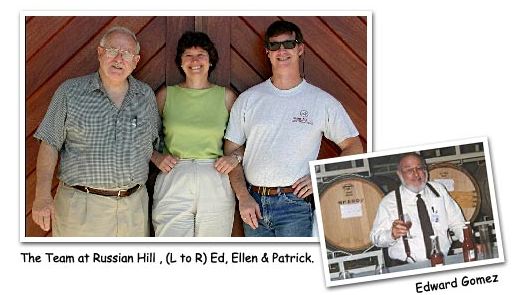 Dr. Gomez retired in 1991 from a distinguished career in academic medicine, seeking to combine his experience in the fields of engineering, electronics, business and government with his love of wine. He was the Chair in the Department of Dermatology and Associate Dean for Clinical Affairs and Professor Emeritus at University of California Davis School of Medicine. He enjoys the mechanical aspects of a winery, and is frequently involved in installing plumbing, rewiring, reassembling, fixing something, or just tinkering. Much of the Russian Hill Estate winery was designed by Dr. Gomez. Mack was formerly a neurologist and neuro-oncologist with the University of California at San Francisco. She is now responsible for the day-to-day operations of the winery as President, and no longer is a practicing physician in academic medicine. She is active in both the wine and medical communities and has served as an officer of the Russian River Valley Winegrowers and as a member of Women for Winesense and the Society of Medical Friends of Wine. She also serves on the Research and Education Committee of the Wine Institute and is interviewed frequently by national media, including CNN, ABC News, and Discovery Health Channel, and has written commentary for DrinkWine.com as a source for scientific perspectives on wine and health. Ellen feels that medicine and winemaking are of the same philosophy in that each is both a science and an art form. She says, “They both require a balance between two different types of thinking. I find wine a gratifying culmination of science, art and passion.” Ed chimes in, “Ellen was intuitively an excellent physician and that is also true with her foray into viticulture.” Ellen’s primary current interests are vineyard development, including site selection and variety and clonal selection. Dr. Mack and Dr. Gomez, and their nephew, winemaker Patrick Melley, conceived and founded Russian Hill Estate Winery in 1997 after a two year search for an appropriate property. A majestic southern-style white building anchors the property with the adjacent former dog kennel serving as a tasting room. The tasting room, which opened in 2003, is particularly striking, opening onto a large patio with an expansive 180 degree vista of the Russian River Valley. The winery specializes in Pinot Noir and Syrah, and released its first vintage in 1999. A total of 30 acres of estate vineyards are farmed. The estate Tara Vineyard, named after the stately residence adjacent the winery, was planted to clone 115 by the Dutton family in 1998 and the first wine from this vineyard in 2001 won a Gold Medal and Best of Class at the Sonoma County Harvest Fair. Top Block Vineyard at the top of the property hill adjacent the winery consists of 3 acres planted in 1998 to Syrah. Ellen’s Block, close to Top Block, was also planted in 1998 to Syrah. Sunny View Vineyard is six miles south of the winery and was planted in 1999. This vineyard includes Pinot Noir clones 667, 777 and Pommard. It supplies the basis of the estate Pinot Noir in additional to Viognier grapes which are sold to several wineries. Grapes have also been sourced from Leras Vineyard and Meredith Vineyard for vineyard-designates. Russian Hill wines are sold through the online web store at www.russianhillestate.com. The tasting room is open daily from 10:00 to 4:00 at 4525 Slusser Road in Windsor.
2010 Russian Hill Russian River Valley Pinot Noir 14.5% alc., pH 3.73, TA 0.58, 2,033 cases, $35. Select fruit from several small growers to represent the appellation as a whole. 100% de-stemmed, 5-day cold soak, pneumatic punch downs, aged 11 months in 20% new French oak. · edium reddish-purple color in the glass. Nicely perfumed with aromas of Bing cherries and Asian 5-spice. Very smooth and plush on the palate with a deep cherry liquor flavor. Veers to the ripe side with some showy oak at play. Good (+).
2009 Russian Hill Estate Vineyards Russian River Valley Pinot Noir 14.5% alc., pH 3.57, TA 0.61, 1,262 cases, $40. The winemaker’s favorite lots from the estate. A majority of the fruit for this wine is from Sunny View Vineyard, located to the southeast of the winery in the Santa Rosa Plain. Planted in 1999 to clones 667, 777 and Pommard with one additional acre later budded over to 828. A small portion is sourced from Tara Vineyard, clone 115. Aged 16 months in 30% new French oak barrels. · Medium reddish-purple color in the glass. Aromas of cherry pie glaze, very ripe black raspberries, spice and oak. Supple and plush on the palate, with flavors of black cherries, cola and subtle herbal oak. The fruit flavors veer to the ripe side. Very Russian River Valley in character with good intensity, mild fine-grain tannins, and a satisfying cut of acidity on the finish. Tasted the next day from a previously opened and re-corked bottle, the wine retained its appealing softness, its most appealing feature, but there is a bit too much oak at play. Good.
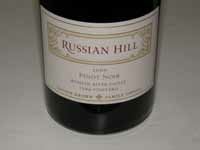 2009 Russian Hill Tara Vineyard Russian River Valley Pinot Noir 14.7% alc., 345 cases, $54. This vineyard is adjacent the winery on an easterly facing slope of the hill and was planted in 1998, later field budded to clone 115. Yields 1.9 tons per acre. · Moderate reddish-purple color in the glass. Brooding aromas of dried cherries and oak. Middleweight sensual flavors of black cherries and spice backed by supple tannins, and offering a soft, smooth and satisfying drinking experience. Nicely balanced, with well-integrated oak, the flavors trumping the aromas on this occasion. Still shy on the nose the following day from a previously opened and re-corked bottle. Good (+).
Undergraduate: University of Texas Austin
Elias Hanna emigrated to the United States from Syria at age 17 to study at the University of Texas. During his residency, he was mentored by Michael DeBakey, M.D. and Denton Cooley, M.D.. He was drafted by the Army in 1969 and served as the only active cardiac surgeon in Saigon, Vietnam. While he was there, he treated many Vietnamese children with congential heart disease. He became a world renowned cardiac surgeon based in San Francisco, where he was Chief of Thoracic Surgery at St. Mary’s Hospital. Pictured right below.
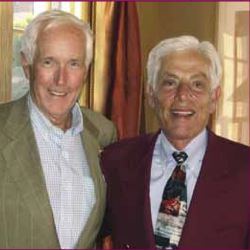 Dr. Hanna spent part of his career serving patients with heart conditions all over the world. Now retired, he took 48 medical trips to 28 countries and in each country was the first cardiac surgeon to ever perform bypass surgery there. Upon his retirement, he had performed more than 24,000 open-heart operations. He now devotes much of his time to the winery but continues to serve as founder and president of Elias S. Hanna, M.D. Cardiovascular Foundation, a charitable organization that assists countries that lack resources necessary to perform open-heart surgery. Hanna’s family grew crops including grapevines in Syria. When he moved to San Francisco, he missed the pace of farm life. Beginning with 12 acres of vines and a ramshackle farmhouse in the Russian River Valley purchased in the 1970s, he and his children started making Chardonnay and Cabernet Sauvignon at home. In mid 1985, he hired Merry Edwards as winemaker, expanded vineyard holdings, and established Hanna Winery on Occidental Road in the Russian River Valley. Today, the Hanna family owns 600 acres, 250 of which are planted, split between four different vineyards. The Home Ranch at the winery facility is the flagship vineyard, with 25 acres planted to Chardonnay and Pinot Noir. The Home Ranch Block 3 was planted to three clonal selections from Torres, Cambria and Mondavi in 1992. In 2008, an additional 12 acres was planted using budwood from the original Block 3, along with some clone 667. Dr. Hanna’s eldest daughter, Christine, is the winery’s President and has been running the winery for over 20 years. Currently, the winery produces 50,000 cases of multiple varietals including Pinot Noir, about half of which is Russian River Valley Sauvignon Blanc. The winemaker is University of California at Davis graduate Jeff Hinchliffe. There are two Sonoma County tasting rooms: the Alexander Valley Hospitality Center is located at 9280 Highway 128 in Healdsburg and is open daily. This venue is home to the winery’s flagship Cabernet Sauvignon and Merlot. The Russian River Estate and Hospitality Center is located at 5363 Occidental Road in Santa Rosa and is also open daily. This intimate tasting room is surrounded by Chardonnay and Pinot Noir vines. Various special wine tastings are available by appointment. The wines are sold online on the winery’s website at www.hannawinery.com. Listen to Christine talk about Hanna Winery & Vineyards on Grape Radio, Show 321, April 8, 2013.
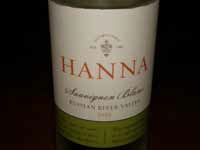 2012 Hanna Estate Grown Russian River Valley Sauvignon Blanc 13.2% alc., pH 3.20, 26,000 cases, $19. 63% of the blend came from the estate Slusser Ranch Vineyard. Average harvest Brix 22.3º. Fermented and aged in stainless steel on the lees. · Straw yellow color with a slight tinge of green and clear in the glass. Aromas of limes, yellow grapefruit and cut grass. The grassy theme carries over on the palate in a New Zealand style with added flavors of lime zest, green apple, and a hint of green pepper. The hi-tone acidity leaves a refreshing impression on the crisp finish. Good.
Undergraduate: Chemistry
Dr. Londer worked in a liquor store across the street from the medical school he was attending in the 1960s in Denver. He stocked the shelves and did deliveries, but when the store was quiet, he would go in the back and study. While he had no interest in hard liquor, and did not like beer, wine fascinated him and he knew a little about it. Over time, he learned as much as he could about wine, particularly wines from France and Italy, and began to drink and enjoy wines that he could afford. He can remember drinking Gallo Hearty Burgundy, but could not afford to buy most French wines, which were less than twenty dollars a bottle during his medical training.
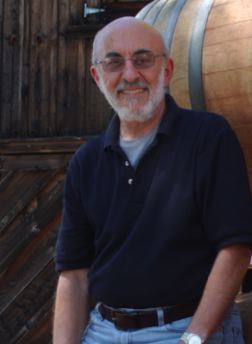 Once he began practicing ophthalmology in Albuquerque, New Mexico, he began collecting wine, joined wine clubs, and started a gourmet and wine group which met monthly. When the New Mexico Symphony got into financial trouble, someone suggested a wine auction to raise money. Dr. Londer’s spouse, Shirlee, became their general chairperson and he was in charge of sourcing wine donations for the auction. Together they visited and met with the principals of dozens of wineries. The more they visited California, the more they wanted to “retire” and start a winery in Northern California. They would say, “This is heaven and maybe we should retire here.” Along with begging for wine donations, they started looking for land and wineries for sale. In 1999, the couple left New Mexico after Dr. Londer’s 27 years in practice, settling in the Anderson Valley just outside of Philo on a 53-acre rural estate to start Londer Vineyards. Londers’ family and friends saw the move as “bold, brave, gutsy and just plain nuts.” They did not know a soul when they arrived but the Anderson Valley is made up of many people who came from somewhere else, so they quickly assimilated. A small, 16-acre estate vineyard was planted (15 acres of Pinot Noir and 1 acre of Gewürztraminer), and they set about sourcing grapes to produce additional Pinot Noir and Chardonnay. Winemaker Greg La Follette got them started with their first releases in 2001, and Dr. Londer learned most of the winegrowing and winemaking aspects of a winery during his 4-year apprenticeship with La Follette. Richard Davis, who worked with La Follette for many years, eventually took over the winemaking duties. Veteran winemaker Eric Stern became the consulting winemaker in the spring of 2012. Londer Vineyards wines have received many accolades and the winery helped lead a revolution in Anderson Valley Pinot Noir over the past 15 years. Their Pinot Noir lineup varied, but usually included an Anderson Valley, Ferrington Vineyard, Estate Grown and Paraboll (a reserve) bottling. Total production reached 6,500 cases. A modern tasting room was opened in downtown Boonville that brought many visitors to the Anderson Valley. Dr. Londer told me, “The winery is like Chemistry 101 and relatively understandable to physicians with a chemistry background. That coupled with an acquired taste for wine leads physicians to think they can successfully run a winery. Physicians are often naive because they usually have little or no background in viticulture, sales and marketing. If those can be learned, then the project has a chance of succeeding.” In 2011, the Londers sold their home and estate vineyard in Anderson Valley to a neighbor and initially managed the winery from their home in their native Colorado. The rigors of travel selling their wines, the operation of a full time tasting room, and the demands required in the management and marketing side of the winery had taken its toll. In May 2013, they left the business completely to devote more time to their children and grandchildren in Colorado. The winery is selling off its remaining inventory.
2009 Londer Vineyards Ferrington Vineyard Anderson Valley Pinot Noir 14.4% alc., $45. · Moderately dark reddish-purple color in the glass. Lovely perfume of fresh dark berries and black grapes with spice in the background. The flavors echo the nose with added hints of cola, sassafras, oak and chalky earth. Very tasty with a graceful and polished demeanor, and impeccable balance. The very long finish is flush with fruit and citrus-driven acidity. A superb wine from a cherished vineyard.
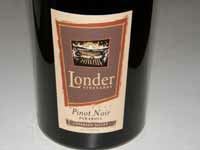 2010 Londer Vineyards Paraboll Anderson Valley Pinot Noir 14.5% alc., $24.99 (SR $54 but discounted at retail stores due to closing of winery - this price is at Bottle Barn in Santa Rosa). A Reserve bottling sourced from Ferrington and Valley Foothill vineyards. · Moderate reddish-purple color in the glass. Very shy aromatics revealing delicate scents of dark red cherries and berries. Beguiling core of perfectly ripe black cherry and black raspberry fruit with balanced tannins and tempered oak. Soft and smooth on the palate, finishing with grace and intensity. The powerful and lengthy finish is the most impressive feature of this wine. Still could use more time in bottle, or decant if you must drink now. A steal at this price.
Undergraduate: Cornell University, English Literature, 1994
Dr. Overstreet is the only female physician winemaker I am aware of other than Laura Catena, M.D.. After completing her training in Pathology, she practiced briefly at Kaiser San Diego, leaving after the birth of her son. Two years later, twin girls arrived. A cool fact is that an abnormally high percentage of female pathologists who also completed Dr. Kurt Benirschke’s placenta pathology fellowship went on to have twins. Although she was recruited to return to medicine, the germ of Bruliam Wines was born and she never returned to the practice of medicine.
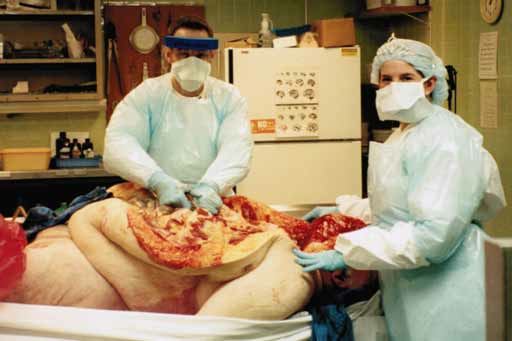 Interestingly, during the one year hiatus between her surgical internship and pathology residency, she did a stint at the now defunct College of Food in San Diego, intent on eventually transferring to the California Culinary Academy. She had aspirations to be a chef, and it was great fun, but never pursued this seriously. Dr. Overstreet started getting serious about wine while in medical school. Each fall, a fellow student and she would split a case of Beaujolais Nouveau. This was a significant upgrade from the “Gato Negro” she drank in college. By the end of residency, she became part of a full-fledged wine tasting group. Never mind that the thematic content included “Box Wines and White Trash Food,” a tasting at which she made a Dorito casserole and wore an orange house dress. Dr. Overstreet made her first barrel of Pinot Noir in 2008 at Crushpad in San Francisco. She had planned for 50 cases, but had to dump the Anderson Valley barrel due to smoke taint. She said, “It was love at first crush. The ineffable mix of science and art was intoxicating.” She increased production and stayed at Crushpad for through the 2009 vintage. Concurrently, she completed the enology certificate program at University of California at Davis. She finally shook the Crushpad “training wheels” in 2010 when she crushed a small lot of Rockpile Zinfandel at Mauritson Winery in Healdsburg where she now continues to craft her wines. The name, Bruliam stands for the amalgamation of her children’s names, Bruno, Lily and Amelia. Since her passion for wine and family imbues everything she does, it is “elemental to her life,” and the winery’s tagline is “Wine is Elemental.” She therefore settled on a logo that riffs on The Periodic Table of Elements. She says, “Since cadmium, boron and polonium were already taken, we had to settle for our own imaginary element. One part nerdiness plus two equivalents love and passion makes for great wine.” The Overstreets fell in love with Healdsburg on their honeymoon and finally moved permanently to Healdsburg in 2011. She began to make more contacts for fruit sources, seeking out the best growers and purchasing top shelf fruit. She was both naive and fearless about cold calling famed growers and asking for 1 to 2 tons of fruit. Some of them laughed out loud at her request, but all of them ended up agreeing to work with her after she bribed them with homemade cakes, pies and galettes, a tradition that continues to keep her in their good graces. After five years of production, Dr. Overstreet finally understands what she wants to do with her wines and knows how to accomplish those goals. Recently, the Overstreets bought a small Pinot Noir vineyard (formerly Two Sisters, now named Torrey Hill) of old plantings of Martini clone in the Russian River Valley, but will continue to work with their grower partners in the Anderson Valley, Sonoma Coast and Santa Lucia Highlands. Bruliam was envisioned as a not-for-profit venture from the beginning. Fortunately, her spouse, Brian, can support the family through his business. Dr. Overstreet believes in karma, service and contribution. Bruliam is an expression of her desire to give back not only dollar value philanthropy, but also because her life is so blessed. She can pursue a passion on her own terms, and she is humbled with gratitude. Her philanthropic choices include the arts, arts education and programs for veterans. For Dr. Overstreet, her medical training has made her comfortable with biology and chemistry and the science of winemaking comes easy. She notes, “Yeasts are the same, whether they are infecting a patient, proofing bread, or making wine. The art part is more ephemeral.” Today, when asked to speak at industry events, she leads off with a picture of her performing an autopsy during her first year of residency (see photo above) and follows that with a picture of her harvesting grapes on a beautiful fall morning. It vanquishes any questions about why she chose to do what she does.
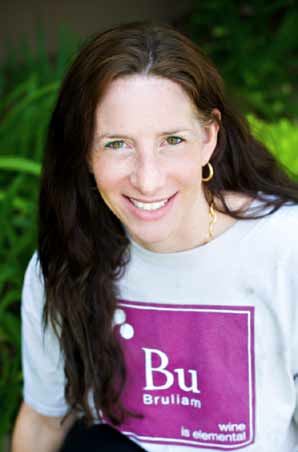 Bruliam Pinot Noirs, Rosé of Pinot Noir and Rocky Ridge Vineyard Zinfandel are sold through a mailing list, with all proceeds donated to the Overstreet Family Foundation. The wines are also available online on the winery website at www.bruliamwines.com. Dr. Overstreet is quite an accomplished writer with a good sense of humor and can be followed on her Bruliam Wine Blog.
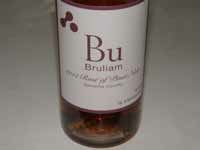 2012 Bruliam Sonoma County Rosé of Pinot Noir 14.5% alc., $20. A saignée of Pinot Noir after 24 hours of skin contact. Fruit is from the Russian River Valley (estate Torrey Hill Vineyard) and Sonoma Coast (Gap’s Crown Vineyard). Fermented and aged in stainless steel kegs after inoculation. No MLF. LIghtly fined for clarity. · Light pink-coral color and clear in the glass. Fresh aromas of strawberries, watermelon, cherry glaze and dried herbs. The flavors echo the nose with some welcome spice. A subtle riff of dried herbs adds an appealing savory accent. The wine is dry and refreshing and not in the tutti fruity genre of rosés. I would drink it with sushi. Very good.
2011 Bruliam Gap’s Crown Vineyard Sonoma Coast Pinot Noir 14.3% alc., pH 3.46, TA 0.462, $55. Picking began a day before September rains. Clone 115. 100% de-stemmed. Saignée for a rosé was followed by minor acid and water additions to replace the volume lost. Aged 10 months in 20% new French Radoux oak barrels and 80% Radoux seasoned oak barrels. Aged 9 months in bottle before release. · Moderately light reddish-purple color in the glass. The nose is enchanting, starting out with aromas of black cherries and evolving to more complexity with scents of sassafras, bark, cola and cinnamon. Elegant and tasty, with mid weight flavors of black cherries and black raspberries and undertones of oak and anise. The fruit is well-framed by good acidity and gentle tannins. The finish is fruit-driven and charming. Very good.
Undergraduate: Oregon State University, General Biology, 1975
Dr. Senders is a Professor of Pediatric Otolaryngology at University of California at Davis where he specializes in facial birth defects like cleft lip and cleft palate. He grew up in Portland, Oregon, and practiced in the Midwest before coming to Davis in 1984. He has served as the director of the Cleft and Craniofacial Program at the University of California at Davis for over 25 years, and was the director of the residency program in Otolaryngology there for 15 years. He is an expert in cleft lip and cleft palate, endoscopic sinus surgery, and surgery for sleep apnea.
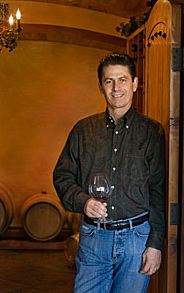 When Dr. Senders moved to Davis, he had only a passing interest in wine. He then began to assist his neighbor who made wine at home, became attracted to winemaking, and began making wine at home. He soon had success and won many awards for his home-crafted wines. Eventually Senders Wines was launched and released its first wine from the 2005 vintage. The small winery specializes in small lots of Cabernet Sauvignon from Napa Valley and Pinot Noir from the Russian River Valley, Sonoma Coast and Carneros. Dr. Senders makes his wines at Bin to Bottle, a custom-crush facility in south Napa, only 45 minutes from Senders’ home, and his spouse Karen markets and sells the wines.
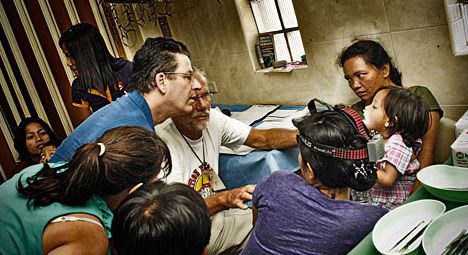 100% of the profits since the inception of the winery in 2005 are used to support medical outreaches for children and adults with cleft lip and cleft palate. The winery’s byline is “Wines with a Cause.” Dr. Senders has participated in over 30 pro bono outreaches through the Face to Face organization, performing cleft lip and cleft palate surgeries for children and adults who cannot afford his operations. In this manner, he is able to blend his passion for practicing medicine, handcrafting fine wines, and supporting medical outreaches throughout the world. He has won several humanitarian awards for service to the less fortunate in the world. Senders Wines donates $100 to medical outreaches for every new Wine Club membership. The wines are sold online at www.senderswines.com.
2009 Senders Reserve Sonoma Coast Pinot Noir 14.2% alc., pH 3.73, TA 0.61, $45. Sourced from Old Adobe Road Vineyard in the Petaluma Gap, clones 667 (70%) and 777 (30%). Aged 11 months in 50% mew Billon French oak barrels. · Moderate reddish-purple color in the glass. Aromas of cherries, dark chocolate, black olive and mushroom. Tasty, middleweight flavors of cherries with hints of chocolate and sassafras and oak in the background. Soft in the mouth with some finishing presence. Good.
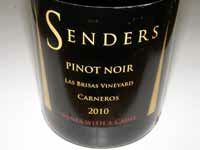 2010 Senders Las Brisas Carneros Pinot Noir 13.9% alc., 170 cases, $38. Sourced from Las Brisas Vineyard, clones 667, 777 and Swan. Aged 18 months in French oak barrels. · Moderate reddish-purple hue in the glass. The nose offers appealing aromas of fresh cherries, forest floor and herb garden. Vivid black cherry and dark red berry fruits are featured with a finishing touch of spice. The tannins are nicely balanced, the texture is silky, and the black cherry really sings on the well-endowed ending. Very good (+).
Undergraduate: Stanford University
Dr. Shoemaker spent six months studying in Florence when he was nineteen and it was there that he met with wine as a matter-of-fact, pleasant, and unpretentious part of the evening meal. Wine wasn’t a “score” that he had to make with a fake ID in a liquor store. It wasn’t a sexual thrill and it wasn’t a macho overture. It was just supper. The Tuscan families introduced him to the customs of winemaking, to an understanding of history in the soil, to a sense of respect among generations, and to the practice of sharing with strangers. He returned to Stanford University, and based on his exposure to the humanities in Italy, he switched his major from metallurgical engineering to medicine. He became involved with a farm worker organization in the San Joaquin Valley and helped establish a free clinic for migrant workers known as the Livingston Community Health Center. Medical school and pediatric residency followed, and Shoemaker realized that there was a world of wine that he could not afford. A friend introduced him to Ridge Zinfandels of the 1960s, and those became his standard of quality. After settling into practice in the Monterey Bay area, he founded the first intensive care nursery in the region, and launched one of the first hospital-based lactation centers in Northern California. Dr. Shoemaker learned how to taste and understand wine by visiting wineries, and finally decided he wanted to do it himself. As he said, “I guess I’d rather be a wine player than a wine Spectator.” He started as a home winemaker and took many courses from the University of California at Davis Extension. His wines did well in competitions, and in 1985, he opened Salamandre Wine Cellars as a commercial, bonded winery, with partner Dave South, M.D., a dermatologist. In the early 1980s, Shoemaker began collecting medical information about wine, wrote about wine and health for several trade journals, and served as Chairperson of the Scientific Advisory Board to the Wine Institute of California. California wineries were uneasy with his role as science advisor because it is illegal for a winemaker to state anywhere on a container or in any winery sales information anything that even remotely implies a health benefit to any alcoholic beverage. The gray area of concern was whether a physician could write something scientifically valid about health effects, whether positive or negative, in a printed article other than a sales article if that physician was also a licensed winemaker. Shoemaker had to be very cautious about that gray border.
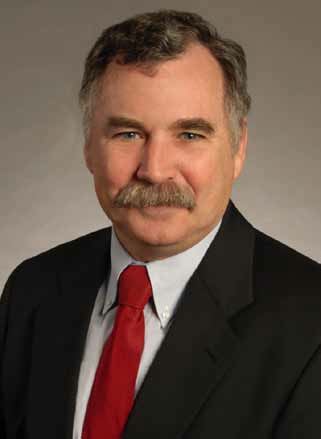 Along with Lewis Purdue and Keith Ian Marton, M.D., Shoemaker wrote the book, The French Paradox and Beyond (1992). He appeared on the cover of the AMA News in the mid 1990s that contained an article on why doctors get into wine. A reader from one of the slave states wrote in a letter to the editor that Shoemaker was a traitor to the Hippocratic Oath by saying anything good about killer alcohol! When he lectured to medical and winemaking groups on wine and health, the winemakers would often remark, “Here is another dilettante doctor tax-dodger getting into the wine business.” Other doctors would say politely, “Well, how can be objective since you’re making all that money in the wine business.” For the doctors, he had to remind them that he did not choose pediatrics for its investment potential and small winery economics (Salamandre produces about 2,000 cases a year) are financial foolhardiness. It took seven years of dedicated labor for Salamandre to break even. Shoemaker has now been making wine for 29 years and is proud of the quality of his work, but it is a distant second among his professional priorities, and it does not come up much these days in his medical interactions. He crafts a number of different varietals, but Santa Cruz Mountains Pinot Noir has been one of his most popular wines. Since 2000, Shoemaker has relinquished his participation in the public interface and spends all his energies on population-based delivery system reform as the Medical Director of the California Association of Physician Groups. He is also a member of the Governor’s task force, writing a ten-year plan for California, and a spearhead for an exciting new primary care institute. Shoemaker told me that was once asked by the wife of a minister how he could dedicate his life to helping children, then turn around and make “alcohol.” Shoemaker reminded her that Jesus performed his first miracle by transforming seven stone cisterns of water into wine. His mother urged him to do it, since there was no wine to properly celebrate the wedding in Cana. Shoemaker pointed out that the medical and clerical paths have been intertwined with wine throughout the history of human civilization. On the relationship of doctors and wine, Shoemaker says the following. “Beyond the intrigue of the unfolding awareness of the relationship of moderate drinking and a variety of health measures, medical training is really useful in other ways in the cellar. To make wine successfully, one must maintain constant suspicion that Nature is not being kind or generous. The same attentiveness to subtle signs of distress that I have used for decades in the nursery, serves well to intercept problems in the barrels. The pleasure in seeing a fine wine safely through to bottling will never parallel the joy of seeing healthy babies go home with loving mothers, but the hours are more humane, and wine smells better. It is also hard to carry babies to the beach, the mountains, and the desert without lugging a lot of extra stuff. Been there, done that, and now we just pack the corkscrew.” Salamandre wines are sold through a mailing list and on the website. The wines are reasonable priced. As Shoemaker says, “Don’t pay ridiculous dollars for Ego Noir that’s still trying to draft on ‘Sideways’.” The winery is not open to the public but periodic open houses and invitational tastings are held at the winery which is carved into the hillside next to Shoemaker’s home located in a shaded redwood canyon two miles inland from the beaches of Aptos. The Salamandre Wine Cellars website is www.salamandrewine.com.
2009 Salamandre Meadowridge Vineyard Santa Cruz Mountains Pinot Noir 14.6% alc., $34. · Moderate reddish-purple color in the glass. Gracefully perfumed with aromas of black cherry, raspberry and new oak. The flavors echo the nose with added notes of plum and spice. Complimentary tannins and bright acidity combined with a pleasing and generous finish make for wonderful drinking. Very good.
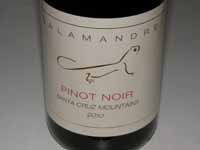 2010 Salamandre Santa Cruz Mountains Pinot Noir 13.7% alc., $32. · Moderately deep purple color in the glass. Lovely perfume of dark berries, fresh picked plums and spice. The aromas are captivating. My notes say WOW on entry. Really delicious, moderately intense flavors of dark berries, black cherries and plum with a hint of spice. The fruit reaches every nook and cranny in the mouth, expanding to finish with unbelievable length and aromatic focus. A complete, harmonious wine of exceptional quality and sure to be one of my All Americans for 2013. (Not listed on website so call or email to order)
Undergraduate:
From 1951 to 1953, Dr. Sinskey was assigned to the Atomic Bomb Casualty Commission in Hiroshima and Nagasaki, Japa, where he studied the eyes of bombing victims. Dr. Sinskey was the first full time staff ophthalmologist at UCLA in 1955 and opened its eye clinic. He also founded the Southern California Lion’s Eye Institute. A pioneer in cataract surgery techniques and surgical instrument innovation, he developed the use of intraocular lenses following cataract surgery and was the first American surgeon to perform the procedure on infants and children. His patented J-loop intraocular lens was widely used as were several of the surgical instruments he invented. He taught small incision cataract and intraocular lens implant surgery to more than 3,000 ophthalmologists at the Sinskey Eye Institute in Santa Monica (including myself) which he founded in 1960. From 1999 to 2000, he served as president of the American Society of Cataract and Refractive Surgery (ASCRS). Dr. Sinskey has been the driving force behind construction and equipping of the ASCRS Foundation’s Robert M. Sinskey Eye Institute in Addis Ababa, Ethiopia. The Sinskey Eye Institute treated over 13,000 patients in 2012 with a full time staff of twelve including two ophthalmologists. He retired from the practice of ophthalmology in 2000. Dr. Sinskey authored a book on his career including a medical history of phacoemulsification and his role in ushering in modern cataract surgery: A Life in Focus (2010).
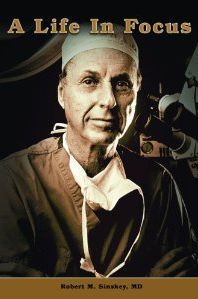 Dr. Sinskey was an investor in Acacia Winery in Carneros in 1980, began planting grapes in Napa in 1982, and established his own eponymous winery now located in the Napa Valley in 1987. From a humble beginning of 15 acres of vineyard land, Robert Sinskey Vineyards now has just under 200 acres of prime vineyards including five Napa Carneros sites and a small 4.8-acre estate vineyard adjacent the winery which is in the Stag’s Leap District of Napa Valley. His son, Rob Sinskey, eventually took over winery operations and winegrowing duties, and the winemaker since 1991 has been Jeff Virnig. Pinot Noir is the focus of the winery and has been produced since 1986. The winery has a reputation for organic and biodynamic farming. Stylistically, the Pinot Noirs are relatively low in alcohol, elegant, with minimal oak encumbrance. The winery’s Vin Gris of Pinot Noir Rosé, produced since 1991, is outstanding. The Pinot Noir lineup includes: Los Carneros Pinot Noir, Three Amigos Vineyard Los Carneros Pinot Noir, Vandal Vineyard Los Carneros Pinot Noir, Capa Vineyard Los Carneros Pinot Noir and a Reserve labeled Four Vineyards Los Carneros Pinot Noir. The tasting room is located at 6320 Silverado Trail in Napa and is open daily. The wines are also sold online at www.robertsinskey.com. Visit the informative website’s Vineyard Kitchen which includes seasonal menus and recipes from Maria Helm Sinskey.
2012 Robert Sinskey Vineyards Los Carneros Vin Gris of Pinot Noir 13.1% alc, $28 (allocated). Whole cluster pressed. · Light orange color and clear in the glass. Aromas of strawberries, oranges and melon. Many flavors emerge over time in the glass including strawberry, cherry, blood orange, peach, and herbal tea. A highly pleasurable rosé that has its own unique vibe and plenty of pizzazz. Very good.
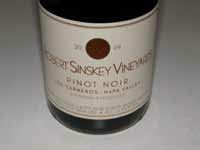 2009 Robert Sinskey Vineyards Los Carneros Napa Valley Pinot Noir 13.4% alc., 6,900 cases, $38. Made from organic grapes. · Moderately light reddish-purple color in the glass. Well perfumed with aromas of fresh black cherries and black raspberries. Earth-kissed flavors of black cherries, dark raspberries and spice with balanced tannins and good supporting acidity. Finishes with reasonable cherry-driven aromatic intensity. This wine has some artisan qualities that one doesn’t expect from such a large production. Good.
Undergraduate: University of California at Irvine, Biology and Biological Chemistry
Years before ‘Sideways,’ Dr. Sterling, along with Santa Rosa radiologist Frank Cutruzzola, M.D. (profiled earlier in this article) became intrigued by the grape and wine business. Dr. Sterling ended up founding Esterlina Vineyards & Winery in the Anderson Valley along with other family members, and Dr. Cutruzzola bought a Pinot Noir vineyard on the Central Coast. Dr. Sterling first became interested in wine mainly as a consumer. He had no real interest in making wine until he bought his first vineyard and made wine from the second crop after noticing how many grapes were left over after harvest. He made his first wines in his barn and they were surprisingly good. He says his background in biochemistry served him well and he found that the science of winemaking was not difficult. He took a few classes in winemaking, read many books, and talked with several winemakers and started to focus on the style of wine he preferred. He then bought the Esterlina property that would allow him to grow grapes in that style. Sterling told me, “People are generally happy in the wine business in contrast to medicine where long hours, stress and the difficult work environment takes its toil. Wine tasters are out to enjoy themselves, and wine is something that people drink when they are relaxing or celebrating. I felt that growing grapes and making wine added balance to my life. That balance is crucial for without it, I would not be as effective in my job and in my life.” He also said, “I think physicians are attracted to winemaking for many of the same reasons they pursued medicine. Both are an art and science. Winemaking allows for development of both halves of our brains. Plus, it’s fun and satisfying to create something from start to finish. I have a full time winemaker now, but still enjoy the winegrowing and blending process. I will go back to full time winemaking when my medical career ends.”
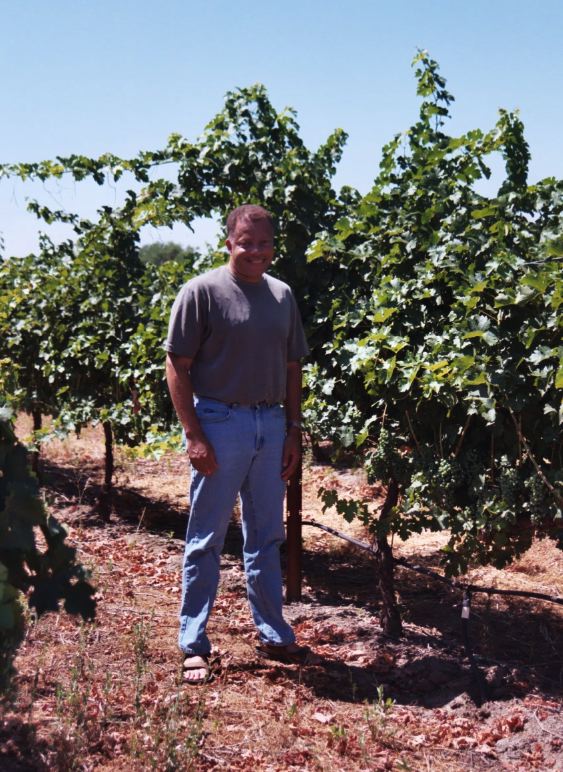 Esterlina Vineyards & Winery is a family operation under the direction of father Murio and his sons Eric, Craig and Steve, specializing in Pinot Noir from the estate vineyard high above the Anderson Valley floor. The site was the former Pepperwood Springs Winery, purchased by the Sterling family in 2000, and rechristened Esterlina which is Spanish for sterling. The Esterlina Pinot Noirs are all from estate fruit and include an Esterlina Vineyard, a Riserva, and a Cole Ranch bottling. The Sterlings also own the 253-acre Cole Ranch AVA in Mendocino County, the smallest AVA in America where the sole vineyard is planted to Pinot Noir, Cabernet Sauvignon, Merlot and Riesling. They also own Alexander Valley Ranch (Everett Ridge Vineyards & Winery) which produces Cabernet Sauvignon and vineyards in the Russian River Valley (Chardonnay and Pinot Noir. Tasting at Esterlina Vineyards & Winery is by appointment and is well worth the circuitous 2.5-mile drive up a dirt road to the winery at 1200 Homes Ranch Road in Philo (707-895-2920).
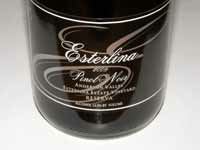 2009 Esterlina Esterlina Estate Vineyard Reserva Anderson Valley Pinot Noir 14.5% alc., $65. · Moderately light reddish-purple color in the glass. Ripe fruit profile featuring blackberry and boysenberry aromas with a hint of oak. Opens beautifully over time in the glass, building gradually in intensity and interest. Flavors of dark red cherries and berries and plum with accents of black tea and cola. Despite its concentration of fruit, the wine retains a refreshing character and is light on its feet. Mild fine-grain tannins add to the appeal. Decant if you open now, but patience will be rewarded.
2010 Esterlina Esterlina Estate Vineyard Anderson Valley Pinot Noir 14.4% alc., $N/A. · Light reddishpurple color in the glass. Aromas of oak-kissed red fruits including strawberries with hints of cedar. Moderately light on the palate, yet noticeable staying power on the long finish. Delicious over time in the glass offering flavors of red and blue berries, baking spice, and subtle oak. Easy to like and very giving. Very good.
2010 Esterlina Cole Ranch Reserva Cole Ranch Pinot Noir 14.5% alc., $N/A. · Light reddish-purple color in the glass. Fresh aromas of brown sugar dusted ripe strawberries and an array of other red fruits. Moderately light in concentration, but plenty of charm and elegance. Juicy, with supple tannins and a persistent, fruit-filled, electric finish. Cause for celebration.
Undergraduate: University of Texas in Austin, Chemical engineering
Dr. Truchard was born and raised on a farm in Sealy, Texas where his grandfather, Jean-Marie Truchard, an emigrant from France in 1885, had planted a vineyard and built a winery in the late 1800s. The vineyard did not survive the hot, humid weather in Sealy, which was close to Houston, so he turned the winery into a barn and raised cattle like all of his neighbors, adding vegetable gardens and pecan, orange and pear orchards. Dr. Truchard learned about agriculture growing up on that farm, but he decided he wanted to become a physician. Dr. Truchard met and married Jo Ann, who was from La Grange. A graduate of the University of Texas, she taught school while he attended medical school. He entered the army his senior year of medical school and after interning at Walter Reed Medical Center and completing his internal medicine residency at Fort Sam Houston Brooke Medical Center, he was sent to Sierra Army Depot in Herlong, California (60 miles north of Reno, Nevada) from 1972 to 1974 to repay his military stipend he used to finish his schooling. Initially, Dr. Truchard was to be sent to Korea, but a month before he was to leave, his pregnant spouse, only days before her scheduled delivery, slipped on a grape exiting a supermarket (true story) and broke her knee. Dr. Truchard told the military he could not leave his wife, and four days later, their son John was born. Instead of being sent to Korea, the family was sent to Herlong, the site of a secret nuclear arsenal. The Truchards lived next door to the commander of the Depot, and were invited to many army functions where they had their first experiences with good wine. In 1972, only a month after they moved to Herlong, Dr. Truchard had to report to the San Francisco Presidio. Afterwards, he and Jo Ann took a drive through the Napa Valley before heading home and the idea of farming wine grapes clicked. Shortly thereafter, impressed by the vineyards he saw and driven by the desire to return to his farming roots, he decided to return and look for property where he could plant a vineyard. He was shocked at the price of property in the Napa Valley compared to the price of land in Texas, and frustrated as he was still on a military salary. A realtor directed the Truchards to Carneros where real estate was less expensive. He found them a 21-acre hillside prune orchard for sale for at $1,589 per acre on Old Sonoma Road, but it lacked water and the soils were very shallow. People told the Truchards they couldn’t grow grapes in this area of deserted orchards. In the early 1970s, the primary method of watering was to dig a well and use overhead sprinklers but the property had no ground water. The realtor arranged for them to meet with a local vineyard manager from the Krug ranch who suggested they dig a reservoir, collect winter rains, and then use drip irrigation. This method had been developed in Israel to water in the desert and was relatively new to viticulture in California. Without drip irrigation, it would have been impossible to successfully establish and grow wine grapes in Carneros. They decided to follow that advice, and bought the property in 1973 while Dr. Truchard was on active duty, with the intention of tending to the property on weekend visits. At the time, there was only about 300 acres of wine grapes in the Carneros - the Krug ranch, BV, Martini’s Stanley Lane Vineyard, Rene di Rosa’s Winery Lake Vineyard, and Francis Mahoney’s Carneros Creek nearby. Francis Mahoney helped the Truchards select budwood and rootstocks, plant the vineyard, and agreed to buy the grapes. Beginning in 1974, they planted Pinot Noir, Cabernet Sauvignon, Merlot, Cabernet Franc and Chardonnay. The Truchards soon began selling fruit to various Napa wineries who welcomed their grapes. Miraculously, over the next 40 years they were able to gradually add adjacent parcels until today they own 400 contiguous acres of which 285 acres are planted to ten varieties of wine grapes. What cost $1,589 per acre in 1973, had escalated to $17,000 per acre in the 1990s and today would be over $100,000 per acre. Early on, Dr. Truchard not only found he could make more money selling grapes than practicing medicine, he enjoyed farming more. Dr. Truchard left the Army in 1974, and continued to practice internal medicine in Reno, Nevada, traveling on weekends with the family (they ultimately had six children), living in a travel trailer while they worked on the vineyard.
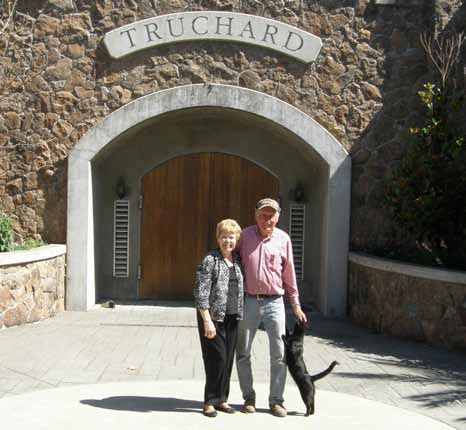 An old barn on the property was converted into a winery in 1989, it was bonded in 1990, and the Truchards began making wine for themselves using estate grown fruit. The barn is very similar to the original Texas winery that Dr. Truchard’s father had built in 1895. It has become the symbol for Truchard Vineyards and adorns the wine label. A 10,500-square-foot wine cave was added later (see entrance above). Today they have six reservoirs on the property to collect rain. Dr. Truchard loves cats and when I visited, the feral black cat pictured above showed considerable love for him, much like a dog and highly uncharacteristic of a feral cat. When asked how many cats he had, Dr. Truchard simply smiled and said, “Too many to count.” Dr. Truchard retired from medicine to tend his vast vineyard and devote all his time to viticulture. His background in chemical engineering has come in handy both in the vineyard and in the winery. The winemaker at Truchard Vineyards since 1998 has been University of California at Davis graduate Sal De Ianni. Today, fifteen different varietals are produced, amounting to 15,000 cases per year. 70 percent of the grapes produced are still sold to about twenty-six Napa wineries. Wineries sourcing Truchard grapes have included David Bruce, Picchetti, Jessup, Saintsbury, Acacia, Bouchaine, Carneros Creek and Artesa. The second generation, including Anthony Truchard II, has taken over management of the winery. Jo Ann told me that after Dr. Truchard retired from medicine, he spends all his time outdoors and refuses to sit behind a desk. After a marriage lasting 49 years so far, she tries to help him by handling the desk work for him. She was kind enough to supply much of the information reported here and give us a tour of the Truchard property. She said that they are often asked what draws physicians to wine and she is not really sure of the answer. “Maybe it is the appreciation of the finer things of life.” Tours and tastings are available by appointment Monday through Saturday (707-253-7153) at 3234 Old Sonoma Road in Napa. The website is www.truchardvineyards.com.
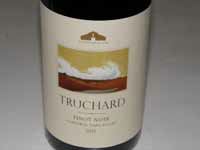 2011 Truchard Carneros Napa Valley Pinot Noir 14.1% alc., $35. Recent release with revamped, modernized label. Seven clonal selections in the blend. · Moderate reddish-purple color in the glass. The nose unfolds slowly in the glass revealing compelling aromas of darker berries, mushrooms and clove-scented oak. Dark red and black fruits are featured with a pleasing earthiness and complimentary oak. Nicely balanced and easy to drink, with a silky mouth feel and commendable finishing intensity. Should benefit from another 6 to 12 months in bottle. Very good.
Undergraduate: Northwestern
Dr. Tweten is a practicing anesthesiologist who has a Pinot Noir vineyard located in the Petaluma Gap region of the Sonoma Coast and sells grapes to a number of wineries. He told me the following about the joys of vineyard ownership. The photo below was taken the day he bottled his first personal effort at winemaking and he notes, “wine grape growing and winemaking really is a family affair.”
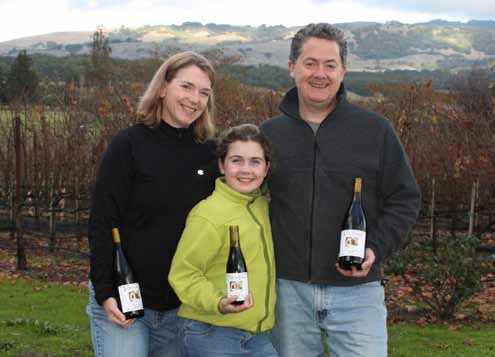 “The vineyard has an annual cycle that is on a scale similar to the gestation of a child. Each season has its chores and routines. After six harvests, I am finally ahead of the curve and not merely trying to keep up, although the vineyard managers have made sure things happened when they needed to. Although there is a rhythm to the season in the vineyard, no two seasons have yet been the same. Spring has been early or late, with frost or not. Summer has been hot, cool and even non existent. Fall has had rain, Indian summer or too little head to bring the fruit into balance. Winter has been wet, dry, or brought snow on a nearby mountain.” “I am beginning to understand what each year has meant to the wine of that vintage, especially now that I have tried my hand at making my own barrel each year. And, as if the season of the vineyard isn’t long enough, add an additional year for the rhythm of the wine. Maybe the gestation of an elephant is a better example.” “Most of my physician colleagues drive nice cars. A few Porsches, many BMWs and one even owns a DeLorean. For me, I look forward to pulling my Kubota out of the shed and spending a few hours amongst the vines where the cares of the world don’t reach me.” You can follow Dr. Tweten’s seasons in his vineyard at www.volamusvineyards.com/blog, “Adventures of a Gentleman Grape Grower,” a limited work in progress.
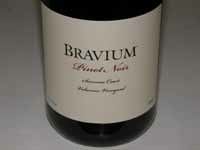 2011 Bravium Volamus Vineyard Sonoma Coast Pinot Noir 14.2% alc., pH 3.45, TA 0.61, 96 cases, $34. 4,500 vines on 3.5 acres. Clones 115, 667 and Pommard farmed sustainably. Hand pressed, 25% whole cluster, racked once after MLF, aged in 50% new 4-year air-dried Francois Frères oak barrels. Unfined and unfiltered. · Medium reddish-purple color in the glass. A more serious, complex wine that will benefit from more time in the bottle. The aromas open slowly in the glass to reveal hi-tone notes of dark berries, spice, forest floor and a hint of vanilla. Dark berries are the featured fruit with undertones of dark chocolate, clove and allspice, all wrapped in dry, chalky tannins, finishing with razor sharp acidity. A little more body, nuance and class than the Sonoma Coast bottling. Very good (+).
Still more “Pinot Noir Doctors.”
Dr. Byck is a graduate of the University of Pennsylvannia Medical School who did his radiology residency at Cornell Medical Center in New York City. After serving in the military, he moved to Santa Rosa in 1965 with his spouse Marijke Hoenselaars. In 1994, the couple opened Paradise Ridge Winery and a year after opening the winery, they launched the first sculpture exhibit in their new Paradise Woods Sculpture Grove. After retiring from medicine in 1997, Dr. Byck turned all his attention to the growing sculpture project. The second generation, including Rene Byck and Sonia Byck-Barwick, are co-owners and managing partners in the winery. Dan Barwick is the winemaker. There are several estate vineyards but none planted to Pinot Noir. The winery’s Russian River Valley Pinot Noir is a consistently reliable offering produced from sourced fruit. The winery website is www.prwinery.com.
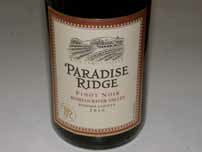 2010 Paradise Ridge Russian River Valley Pinot Noir 13.3% alc., 167 cases, $28.99. · Medium reddish-purple color in the glass. Lovely aromas of fresh black cherries, cola, sassafras and baking spices. Mid weight flavors of black cherries, vivid, crisp and juicy in character, smoothly textured, and finishing with deep cherry aplomb. Quintessential Russian River Valley in character. Very good (+).
Dr. Frankel, a family doctor, moved to a 90-acre ranch in Paso Robles from the San Fernando Valley in 1979 with his spouse Kathy and their three children. The Frankel family first planted 20 acres of pistachios on the ranch, followed by 20 acres of Cabernet Sauvignon. He expanded the vineyard operation in 1997 with the addition of more Cabernet Sauvignon and several other red and white warm climate varieties. The winery and multi million dollar sculpture garden was opened in 2007. In 2002, Dr. Frankel joined with other doctors to found “His Healing Hands,” a medical missionary foundation that sends medical missionary teams all over the world on all five continents. They also respond to catastrophic disasters. He has written about the missionary work in a book, His Healing Hands.” Along with several varietals, a Paso Robles Pinot Noir is produced. The website is www.sculpterra.com.
This winery is located in the Hyampom Valley amongst the inter-coastal mountains of Southern Trinity County in a rugged region of Northern California. Dr. Merlo and his spouse Robin, a physician assistant, started a family practice in Redding, California. Their interest in wine had been piqued upon a visit to family in Northern Italy in the mid 1980s. They visited an old family vineyard planted by Dr. Merlo’s great-grandfather and they thought it might be worthwhile to continue the family tradition back home. It wasn’t until the late 1990s that the Merlos entered into a formal partnership with Randall Meredith of Meredith Vineyards, an established, bonded winery located in Hyampom Valley. They bought Hyampom Valley Ranch and planted a second vineyard in 2000. The first bottling under the Meredith/Merlo label came in 2001. A winery was built in 2002 and a second winery in 2004, when the first bottling under the R. Merlo label appeared. Merlo, Italian for blackbird, offers several varietals including Pinot Noir from Southern Trinity County. The estate vineyards are over 45 acres and include Chardonnay, Pinot Noir, Zinfandel, Syrah, and Merlot. The consulting winemaker is David Georges and the head winemaker and viticulturist is Steven Canter. The winery website is www.rmerlo.com.
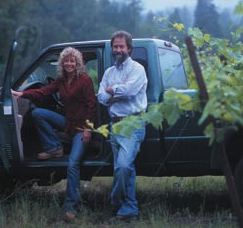
Dr. Thorpe and Naomi Thorpe moved to Northern California in 1980 and bought the 33-acre Carneros ranch that was to become Adastra in 1984. Initially, Dr. Thorpe raised Angus cattle, but in 1989 established Adastra Vineyards, returning the Carneros property to vines for the first time since Prohibition. The vineyard has 7 acres each of Chardonnay and Merlot and six acres of Pinot Noir. Wine production began in 1995 with a small amount of Merlot. All the Pinot Noir was sold to Etude beginning in 1997 until 2002, when some was withheld to produce this varietal under the Adastra label. At present, Adastra sells slightly less than half its grapes to other producers. The vineyards, managed by Dr. Thorpe and his son-in-law Edwin Richards, are CCOF certified organic. The winemaker is Pam Starr. Dr. Thorpe is a retired Vallejo surgeon. The winery website is www.adastrawines.com.
A Los Angeles area Plastic Surgeon and developer of medical devices (Biomedics, Inc.) whose wife, Nadia, and her father, Selim Zikha, bought Laetitia Vineyard & Winery in 2001. Dr. Wellisz produced Pinot Noir under the Malvolio label with fruit sourced from Laetitia Vineyard in the early 2000s.
Marcy Keefer, a former nurse, and her husband, Robert Keefer, M.D., purchased the property near the headwaters of Green Valley Creek in Sebastopol, Sonoma County, in 1985. The vineyard was planted in 1988 on the site of a former apple orchard. Dr. Keefer is now deceased, but Marcy carries on, actively overseeing the farming of the vineyard, selling grapes to several of California’s most noted Pinot Noir producers, and bottling a Keefer Ranch Pinot Noir which her son, Craig Strehlow, crafts.
Dr. Hall and his spouse Deborah, who was a nurse, bought the 290-acre Gypsy Canyon property in 1994. After Dr. Hall passed away in 1997, she sold 160 acres and kept 130 acres with 12 acres of vineyards. She took over winemaking duties upon his passing, and continues to produce ultra-premium Pinot Noir and Ancient Vine Angelica.
A San Francisco-based surgeon and Professor Emeritus at University of California San Francisco died in 2013. He bought an apple orchard on Cherry Ridge Road near Occidental in the mid 1980s and enlisted the Dutton family to plant the Dr. Maurice Galante Vineyard to Pommard clones 667, 777 and Pommard.
Oregon Pinot Noir Doctors
Medical School: Oregon Health & Science University School of Medicine
Dr. Bergström grew up in a small agricultural and logging village in northern Sweden and as a young teenager immigrated to Oregon where he ultimately became a physician and surgeon. He wanted to start a business that would become a legacy for his children and pay tribute to his Swedish agricultural upbringing. After moving the family to Dundee from Portland where he practiced, he planted the Bergström Vineyard on a 13-acre, south facing slope. In 1999, Dr. Bergström’s son, Josh, returned to Oregon after a postgraduate program in viticulture and enology in Burgundy and founded the Bergström label with his father.
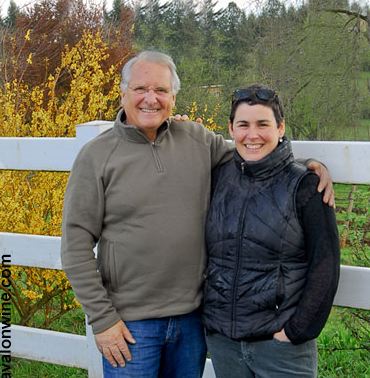 In 2001, Kendall Bergström and her husband Paul de Lancellotti joined the business. A new winery was built at the top of Calkins Lane in the Chehalem Mountains and the de Lancellotti Estate Vineyard was planted. Bergström Wines now farms five estate vineyards totaling 84 acres, all of which are biodynamically farmed (Bergstöm, de Lancellotti, Le Pré Du Col, Winery Block and Gregory Ranch). Pinot Noir is also sourced from Shea and Temperance Hill vineyards. Production is 9,000 cases annually of Pinot Noir (nine bottlings) and Chardonnay. Josh Bergström is currently general manager, winemaker and vineyard manager, and his wife Caroline manages the sales team. Visit the website at www.bergstromwines.com.
2010 Bergström Cumberland Reserve Willamette Valley Pinot Noir 13.5% alc., $42. The winery’s flagship blend. Primarily sourced from de Lancellotti, Shea and Bergström vineyards. · Moderately light reddish-purple color in the glass. Aromas of black cherries, spiced dark berry jam, and mocha java. Fresh and juicy, modest in weight, featuring a core of dark red and black cherries and berries with a noticeable topcoat of oak. About the same the following day from a previously opened and re-corked bottle. Decent.
2010 Bergström Bergström Vineyard Dundee Hills AVA Oregon Pinot Noir 13.5% alc., $80. Yields were less than 0.9 tons per acre in this vintage. This 13-acre site was planted in 1999 and is certified Biodynamic®. · Medium reddish-purple color in the glass. Very shy fruit on the nose with primarily oak-driven aromas. Bright cherry core wrapped in supple tannins finishing with flourish of oak. Juicy and vivid with a good cut of citrus peel acidity in the background. The charming fruit is somewhat buried in oak at present. About the same the following day from a previously opened and re-corked bottle. Good.
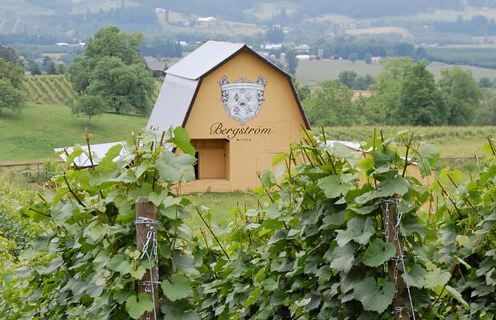
Undergraduate: Harvard University (Magna Cum Laude in History of Science)
Dr. Campbell told me that he and his spouse Pat became interested in wine while he was at Stanford University and on weekends they visited tasting rooms nearby and in the Santa Cruz Mountains. After medical school, he practiced for two years on a Sioux Indian Reservation in South Dakota. In 1971, they visited Oregon. Pat had grown up on orchards in the Hood River so she was familiar with farm life. He started working in internal medicine in Portland and emergency medicine on the Oregon Coast, earning enough to buy property in the Willamette Valley. He founded Elk Cove Vineyards in 1974 in Gaston (Yamhill-Carlton AVA) which today is one of Oregon’s oldest wine producers. He planted his first ten acres of Coury selection Pinot Noir and Chardonnay (later grafted over to Pinot Gris), began making wine in an old barn, and released his first wine in 1977. This was the first commercial wine produced in the Yamhill-Carlton District. Single vineyard Pinot Noir has been offered since 1979. A new winery was built on the property in 1981 and vineyard properties were gradually added over the years. Today, the winery farms over 220 acres of vineyards on four separate sites in the Willamette Valley (Estate, Windhill, Mount Richmond and Five Mountain). Another 150 acres of vines are scheduled to be planted over the next several years. Dr. Campbell made wine for over twenty years while still practicing medicine. He has five offspring, with Adam Godlee Campbell now the winemaker and his youngest daughter managing the winery photography and website. He recalls that in the early years of the winery his two oldest sons worked in the vineyards when they were ten years old, something that wouldn’t be allowed today. Dr. Campbell made wine with his son Adam in 1997 and 1998, and in 1999 Adam took over the winemaking duties. He still works at age 73 years as a family practitioner in Portland (Pearl Health Center) and in emergency medicine on the Oregon Coast. He has volunteered with Medical Teams International following disasters in New Orleans, Sri Lanka and Sol Sudan and supports a small medical clinic in Arequipa, Peru. When asked about his winemaking training, Dr. Campbell told me he had no mentor. He spent a harvest in Burgundy and read everything he could get his hands on. “I attribute my success to hard physical work growing up and a background in chemistry that made the chemistry of winemaking simple.” He was quoted in a Stanford University publication (Bench & Bedside) as saying, “There’s a lot of science in winemaking. Of course, there’s nothing more complex than the human body. But I do think the complexity of wine is attractive to many physicians.”
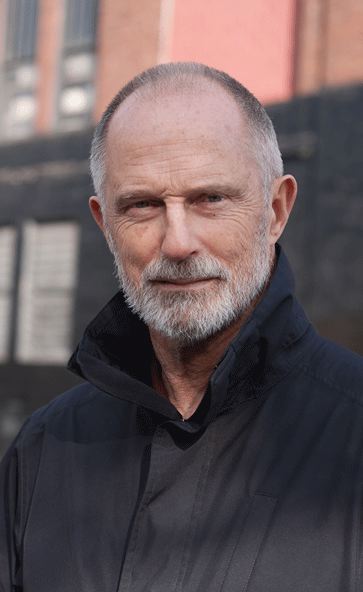 Elk Cove Vineyards was the fifteenth largest producer in Oregon in 2011 (43,800 cases) and was the Northwest Palate Magazine 2007 Northwest Winery of the Year. The winery focuses on Pinot Noir, Pinot Gris and Pinot Blanc. Visit the website at www.elkcove.com.
2010 Elk Cove Vineyards Willamette Valley Pinot Noir 12.5% alc., pH 3.55, 7,227 cases, $29. A blend from several vineyards including Pommard and Dijon clones. Vine age 9 to 37 years, yield 1.6 tons per acre. · Medium reddish-purple color in the glass. Aromas of fresh, dark red cherries, raspberries and strawberries leap from the glass. The rich flavors echo the nose, with a well-balanced backbone of acidity and tannin, and a strong, firm finish. A showy wine with surprising richness for this vintage and the low alcohol level. One of Oregon’s consistently solid value-priced Pinot Noirs. Produced in quantity and widely available. Good (+).
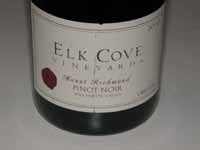 2010 Elk Cove Vineyards Mount Richmond Willamette Valley Pinot Noir 13.5% alc., $48. Vineyard was planted in 1996 with cuttings from Roosevelt Vineyard. Willakenzie soils. · Moderately dark reddish-purple color in the glass. Great nose! Lovely aromas of black cherry fill the glass like fresh cherries just off the tree. Aromas of spice and candied cinnamon apple add interest. A cherry bombast on the palate that is flat out delicious. A sensational wine that is moderately rich but strikingly flavorful and composed in a seamless fashion with modest fine-grain tannins and complimentary oak in the background. Plenty of Pinot singing in this great wine.
Undergraduate: University of Miami
Born in Havana, Cuba in the 1950s, Dr. Collada came to the United States with his family in 1962, a few years after Fidel Castro’s communist revolution. He developed an interest in wine while attending college and began making wine at home from mangoes and bananas. His passion for wine continued through medical school. He moved to Salem, Oregon, in 1983 to begin his neurosurgical practice, and developed a special interest in Pinot Noir.
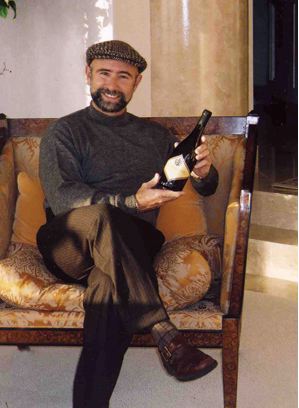 In 1986, Dr. Collada bought a 21-acre parcel in the Eola-Amity Hills, and five years later planted 8 acres of Pommard Pinot Noir on a southeast facing hillside. In 2001, he planted two more acres of Pinot Noir (115 and 777) and in 2007, two acres of Pinot Gris. Initially, he sold grapes to King Estate, Evesham Wood and Erath and through his dealings with Erath got to know the winemaker at Erath, Rob Stuart, who was a mentor. In 2003, he started holding back 50% of his production to produce his own wines under the Cubanisimo Vineyards label. Cubanisimo means “very Cuban.” When his winery contracts expired in 2005, he began to keep all of his production and constructed a wine tasting facility. Cubanisimo wines are currently produced at Rob Stuart’s winery in McMinnville, with plans to move wine production to the estate in the future. Currently Dr. Collada produces 800 cases of estate Pinot Noir and 1,000 cases of Pinot Noir that blend estate grapes with grapes sourced from other vineyards. Production also includes 150 cases of Rosado de Pinot Noir from estate fruit and a small amount of Pinot Gris. His spouse, Debra, is a nurse who participates in harvest, bottling, manages the tasting room and distribution, and coordinates events. Visit the website at www.cubanisimovineyards.com.
2010 Cubanisimo Rumba Willamette Valley Pinot Noir 12.8% alc., $21, screwcap. · Light reddish color in the glass. Aromas of red fruits and briar lead to crisp red cherry flavor with oak-driven notes of spice and tar. A very delicate wine with prominent tannins that dominate the demure fruit. A summer sipper that would benefit from ice. Decent.
2011 Cubanisimo Estate Willamette Valley Pinot Noir 12.8% alc., $30. · Light reddish-purple color in the glass. Aromas and flavors of cherries, raspberries, savory herbs and spice underpinned with notes of tarry oak. Balanced tannins and lively acidity make for refreshing drinking. Good.
Medical School: Texas A&M College of Medicine 1982
Shortly after beginning medical practice, several of Dr. Dragutsky’s medical colleagues who were active in local wine groups invited Dr. Dragutsky to participate in some of their wine events. His first truly memorable wine was a bottle of 1982 Dom Perignon which he tasted at a New Year’s Celebration. Dr. Sloas was a fellow gastroenterologist who Dr. Dragutsky was sharing call with in 1991 when Dr. Sloas had lunch with noted vintner Randy Dunn in Napa. Dunn mentioned that he was going to have 5 extra tons of grapes that year. Dr. Sloas called Dr. Dragutsky immediately and they bought Dunn’s overage of Howell Mountain juice. Dr. Dragutsky was just learning the basics of wine at the time, so he had to make a quick study of both wine and the wine business. Joined by Managing Partner Craig Camp, winemaker Jeff Keene and a group of Memphis-based partners led by Hal Lewis and John Carrier, Cornerstone/Stepping Stone Cellars was founded. Today, the winery produces Cabernet Sauvignon Cabernet Franc, Syrah and Sauvignon Blanc from the Napa Valley under the Stepping Stone and Cornerstone labels. Craig Camp enlisted noted Oregon winemaker Tony Rynders to produce Pinot Noir from the Willamette Valley beginning with the 2008 vintage under the Cornerstone Cellars label and Drs. Sloas and Dragutsky and their investor partners joined in founding the new Oregon winery. Cornerstone now produces both Pinot Noir and Chardonnay from the Willamette Valley. Dr. Dragutsky is pictured below on right with winemaker Jeff Keene. Current production in Napa and Oregon totals over 10,000 cases. Visit the website at www.cornerstonecellars.com. Dr. Dragutsky practices gastroenterology full time in Memphis, TN and is one of the founding members of Gastro One, currently the twelfth largest gastroenterology group in the United States. He is also owner of Phoenix Unequaled Home Entertainment, a nationally recognized residential systems integration company. He spends at least 15 hours a week interacting with Craig Camp and staff in Napa, managing the financials, and promoting Cornerstone Cellars. I asked Dr. Dragutsky why he thought physicians were attracted to wine and the wine business. He said the following. “Medicine is a very socially interactive profession where personal interactions between the physician are of utmost importance. Likewise, wine is the epitome of a social experience. It is this commonality which I believe attracts physicians to wine. In addition, both fields require in depth knowledge and are intellectually challenging. It also confirms the adage that physicians are drawn to bad investments!”
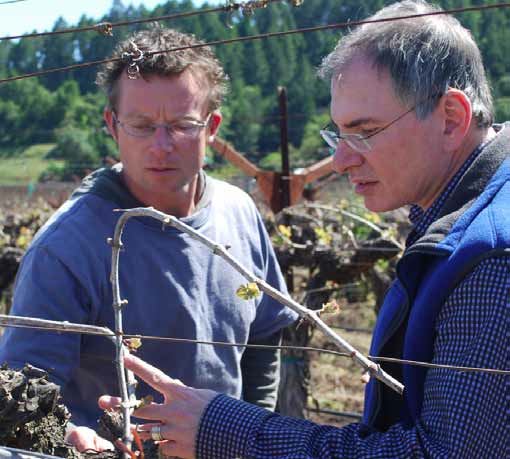
 2010 Cornerstone Willamette Valley Pinot Noir 13.5% alc., 498 cases, $50. Sourced from all six Williamette Valley sub-AVAs with the majority (68%) from the Yamhill-Carlton District. Aged 15 months in 62% new French oak. · Medium reddish-purple color in the glass. Pleasant aromas of black cherries and dark berry compote with a hint of smoky oak. Not as expressive as it will be with more bottle age, yet showing enticing flavors of dark cherries and raspberries pulled into line with fine acidity and tannin. Finishes dry with a flourish of cherries. Nicely composed and balanced and a worthy cellar candidate. Very good.
2010 Stepping Stone Willamette Valley Pinot Noir 13.5% alc., 137 cases, $30. The painting on the label is “Color of Life” by Oregon artist Janet Ekholm. Sourced from all six Willamette Valley sub-AVAs with the majority from Yamhill-Carlton and Eola-Amity Hills. Aged 13 months in 35% new French oak. · Medium reddish-purple color in the glass. Demure aromas of black cherries and toasty oak. Mid weight core of dark cherry fruit becoming more vibrant over time in the glass. Soft in the mouth with mild tannins and some length on the earthy, fruit-driven finish. A straightforward, accessible wine showing a tad more oak than I prefer but otherwise solid. Good. Reviewed November 24, 2012.
Undergraduate: General and Molecular Biology, University of California at Irvine
Dr. Ferry is the only Society of Surgical Oncology-trained physician in Oregon outside of Portland. A surgeon at Oregon Medical Group in Eugene, he has received considerable praise for the Pinot Noir he crafts from the 5-acre Abbelone Vineyard located on the southeastern flank of Spencer Butte in Eugene, Lane County, Oregon (south Willamette Valley). He and his spouse Angela first established the vineyard in 2002. The vineyard is named in memory of Dr. Ferry’s mother and is planted to Pommard, 115 and 777 clones. Dr. Ferry is a respected viticulturist and winemaker who actively works in his vineyard throughout the season, performing eighty percent of the work himself. Come October, he crafts his Pinot Noir at Eugene Wine Cellars, perfecting his technique from winemaker Greg Sothras. His first vintage was a 2009 Pinot Noir. In 2011, Dr. Ferry added more acres of Pinot Noir and may include white varieties in the future. The website is currently under construction. Dr. Ferry’s vineyard started out as a “fun diversion,” and a relief from the long hours he spends in hospitals and operating rooms, but he keeps expanding, now slowly equipping the basement of his villa overlooking the vineyard for winemaking. He attributes his interest in winegrowing and winemaking to an expression for his creative energy.
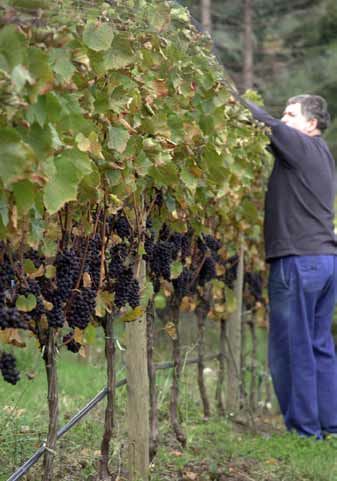
Medical School: Emory University 1966
Dr. Gross was at the University of Washington doing his residency when he and a group of fellow residents started an amateur winemaking group. They rented some space in Pike Place Market before it was renovated and while it was still economically plausible, and began ‘playing’ around. After residency, some of the members of the group went to Eastern Washington to found a now shuttered winery called French Creek. Dr. Gross was not interested in warm climate varieties and neither was his wife Corrine who grew up in Portland. They went south to Oregon to find a suitable location to plant Pinot Noir, and found a 100-acre horse farm in the Chehalem Mountains for sale where Corrine had grown up riding horses. In 1978, they bought the property and planted vineyards which would become the location for Cooper Mountain Vineyards which was established in 1987. When I asked Dr. Gross “Why wine?”, he answered that he already had the organic chemistry background. “Why the emphasis on organics and biodynamics?”, he said that it was for his health. Dr. Gross still practices in Portland and continues to oversee the winery operations and production. Cooper Mountain Vineyards has been a pioneer among Oregon wineries in practicing organic and biodynamic viticulture. Organic certification by Oregon Tilth came in 1995 and Biodynamic® certification by Demeter® followed in 1999. In 2002, Cooper Mountain Vineyards was the first winery in the United States to gain label approval for a no sulfite added wine and carry the USDA Organic seal. The winery’s sulfite free Pinot Noir has developed a cult following. In addition, there are reserve bottlings and single vineyard options. Pinot Gris, Pinot Blanc and Chardonnay are also offered. The winemaker is Gilles De Domingo. Visit the website at www.coopermountainwine.com.
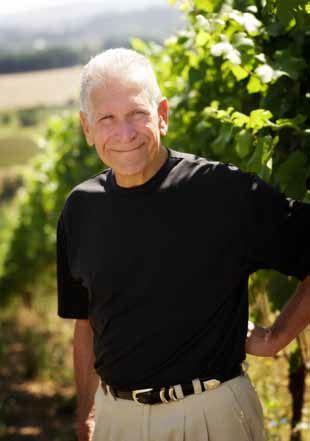
2009 Cooper Mountain Vineyard Mountain Terroir Willamette Valley Pinot Noir 13.5% alc., pH 3.65, TA 0.57, 290 cases, $45. Biodynamic® by Demeter®. · Moderately light reddish-purple color in the glass. Very shy nose with delicate aromas of blackberry jam. Mid weight flavors of plum reduction sauce and blackberries accented with tempered oak, balanced with firm tannins and finishing with notable power. Very tasty and offers a sensual, velvety mouth feel to boot. Very good.
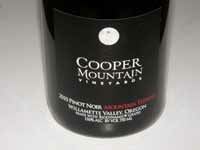 2010 Cooper Mountain Vineyard Mountain Terroir Willamette Valley Pinot Noir 13.0% alc., $50. Biodynamic® by Demeter®. · Moderately light reddishpurple color in the glass. This wine shows a heavy oak topcoat that is currently burying the luscious and markedly intense dark red fruit core. A middleweight wine with restrained tannins and balancing acidity, that will benefit from more time in bottle to fully integrate the oak. That said, this wine displays a remarkably fleshy fruit profile. Good.
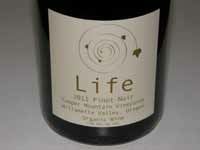 2011 Cooper Mountain Vineyards “Life” Willamette Valley Organic Wine 13.0% alc., $35. No sulfite added during winemaking. Certified organic by Oregon Tilth. Biodynamic® by Demeter®. · Moderately light reddish-purple color in the glass. Very fruity, upfront nose offering aromas of strawberry, cherry, red fruit punch and sandalwood. A Beaujolais styled wine, with pleasant flavors of red fruits including red plum and a subtle hint of savory herbs. Mild, but evident tannins, with a bright finish. Crafted for early drinking and an excellent wine for the table. Good.
Medical School: New York University School of Medicine 1967
Dr. Haussman, a native of New York, and his spouse Deborah, who was raised in the Northwest, established Quailhurst Vineyard Estate in 1997 in Sherwood, Oregon. The 35-acre estate was built in the 1930s and was renowned for its Japanese gardens and many varieties of roses. They renovated the property to grow wine grapes and to breed and train competition dressage horses. The first Dijon clone Pinot Noir vines were planted in 1998 and the first Pinot Noir bottled from the 2001 vintage under the Quailhurst Vineyard Estate label. The vineyard produces about 15 tons of Pinot Noir grapes per year from which several estate Pinot Noirs and Pinot Noir ports are released. The website is www.quailhurst.com. Dr. Haussman has over thirty years of experience in drug development and clinical care experience at various pharmaceutical companies including working with Bristol-Myers International, Mead-Johnson Pharmaceutical Co., and E.R. Squibb. He was the President and CEO of OXIS International until 2008 and Chairman of the Board of Axonyx from 1997 until its merger with Torrey Pines Therapeutics in 2006. This company has patent rights to two main classes of therapeutic compounds designed for the treatment of age related and disease related dementias, in particular Alzheimer’s disease. Dr. Haussman cofounded Medco Research Inc., a pharmaceutical biotechnology company. He has served in executive positions most recently for Entia Biosciences, Inc., Genesis Biopharma, and Total Nutraceutical Solutions. He has focused on formulating and marketing products composed primarily of organic natural mushroom compounds that contain bioactive nutrients for potential health benefits. His special interest in mushrooms has developed because it is believed that when metabolized with food, they provide many nutrients that are invaluable for the human immune system and for normal cellular function.
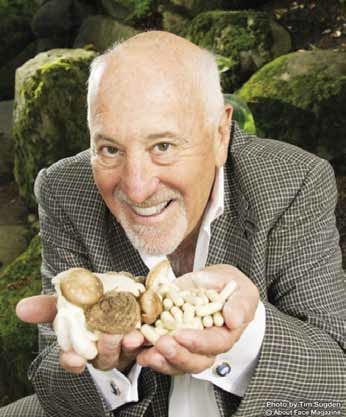
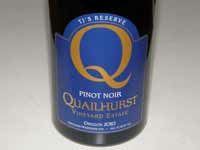 2010 Quailhurst Vineyard Estate TJ’s Reserve Chehalem Mountains Willamette Valley Pinot Noir 13.2% alc., $60. · Moderately light reddish-purple color in the glass. Shy aromas of red fruit, oak and walnuts. Mid weight flavors of red fruits including sweet cherries and cranberries with complimentary oak in background. A feminine style with supple tannins, a good cut of acidity, and impressive cherry fruit on the finish. This wine grows on you the more time you spend with it. Very good.
Medical School: University of Wisconsin Medical School 1961
Dr. Olson founded Torii Mor Winery in the Dundee Hills of Oregon in 1993 as a tribute to his late son, Leif. Olson had been a lover of French Burgundy while a Clinical Professor of Neurosurgery at the Oregon Health Sciences University in Portland. The winery was initially a small project intended to showcase fruit from his vineyard that was planted in 1972, one of the oldest vineyards in the Willamette Valley. Situated at 800 feet, the vineyard is just under 15 acres and is planted to Pinot Noir. The winery released its first vintage in 1993. The name Torri Mor comes from the Japanese, “Torii,” referring to the beautiful gates often seen at the entrances of gardens, and, “Mor,” is a Scandinavian word meaning earth and chosen as a homage to Olson’s Scandinavian heritage. By joining these two languages, an image of a gate to the earth was created. A LEED certified solar-array gravity flow winery opened on the property in 2007. The estate has a quaint Japanese theme and is unique among Oregon wineries. Burgundian Jacques Tardy became the winemaker in 2004. Dr. Olson continues his involvement in the winery as General Manager and CEO. He is at the winery on a daily basis, and very involved with the day-to-day activities of the winery. Current production is 15,000 cases, predominantly Pinot Noir, both appellation-designated and vineyard-designated. The Olson Estate Vineyard is the cornerstone of production, but fruit is sourced from other AVAs and the Umpqua Valley and Rogue Valley. Visit the website at www.toriimorwinery.com.
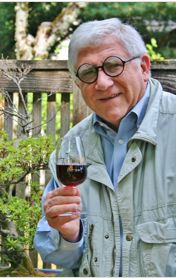 Dr. Olson has been an advocate of the health benefits of wine and given many presentations on the subject. At one time, federal regulators forced him to change the aphoristic “make glad the heart with wine” on his label because it represented an apparent “health statement.” In 2011, after a break from neurosurgery for ten years, Dr. Olson volunteered with Medical Teams International to perform battlefield surgery on freedom fighters in Libya.
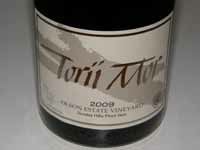 2009 Torii Mor Olson Estate Vineyard Dundee Hills Willamette Valley Pinot Noir 13.9% alc., 350 cases, $60. Pommard, Coury and 667 clones. Yields <2 tons per acre. Aged in 10% new, 18% 1 and 2-year-old, and the rest neutral French oak barrels. · Moderately light reddish-purple color in the glass. Aromas arrive over time in the glass, showing scents of black cherries, black plum, and a hint of oak. Medium weight flavors of black cherries, dark red berries, black tea, anise and oak backed by some drying tannins and lively acidity. The wine finishes with pleasing aromatic intensity. Very good.
2010 Torii Mor Oregon Pinot Noir 12.9% alc., $24, screwcap. · Light reddish-purple color in the glass. Delicate red fruit aromas with prominent smoky oak. Austere with flavors of tart red cherries, spice and a green note in the background. Very mild tannins and brisk acidity. The fruit appears under ripe and oak shows up with unwelcome dominance. Decent.
2010 Torii Mor Reserve Deux Verres Willamette Valley Pinot Noir 13.6% alc., 650 cases, $38. Deux Verres means “Two Glasses” in French. Sourced from six vineyards in the Dundee Hills and Chehalem Mountains. Aged 15 months in 20% new, 41% 1 and 2-year-old, and 33% neutral French oak barrels. · Moderately light reddish-purple color in the glass. Dark red fruits are featured on the nose and palate. Relatively modest in weight, but flavorful, featuring red cherry and cranberry tastes. Juicy, with mild tannins and a good cut of citrusy acidity. Good.
Medical School: Mysore Medical College India (first in his class)
Dr. Revana grew up in rural India near Bangalore where his family had been farming for generations. This farming heritage led to his instinct for winegrowing. He was first introduced to wine by friends and became fascinated with Bordeaux’s first growths while practicing cardiology in Houston, Texas. He traveled to the wine regions of Europe and the United States and became determined to establish a world class vineyard estate. In 1997, on a visit to the Napa Valley, he found a small parcel of prime vineyard land in St. Helena. In 1998, he hired vineyard manager Jim Barbour to plant and maintain the 9-acre vineyard. He started Revana Family Vineyard, and released the first vintage in 2001. Noted winemaker Heidi Barrett was the initial winemaker and today Thomas Brown directs the winemaking at Revana.
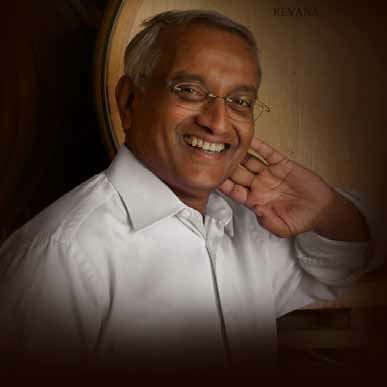 In time Dr. Revana developed a love for great Burgundy wines as well. After enlisting the assistance of winemaker Lynn Penner-Ash (Rex Hill from 1988 to 2002 and now Penner-Ash Wines), he acquired 80 acres in the Dundee Hills in 2005 and started Alexana Winery, named after his daughter, Alexandra Revana. 16 acres of Pinot Noir and Pinot Gris had already been established and an additional 39 acres of Pinot Noir, Riesling and Chardonnay was added. Today, the vineyard, which has an unusually complex diversity of soils and exposures, has grown to over 55 acres. Lynn Penner-Ash became the winemaker for the new winery and is currently assisted by associate winemaker Brian Weil. The first two Alexana estate wines, a Pinot Noir and Pinot Gris, and a Pinot Noir from Shea Vineyard, were released from the 2006 vintage. Production is now 5,000 cases annually. A tasting room in a LEED certified Gold three-story house is located on NE Worden Hill Road in Newberg. Visit the website at www.alexanawinery.com.
2010 Alexana Revana Vineyard Dundee Hills Willamette Valley Pinot Noir 13.1% alc., 1,654 cases, $42. A blend of eight clones. · Moderately light reddish-purple color in the glass. Lovely nose offering aromas of black cherries, black raspberries, and subtle oak spice, fading a bit over time in the glass. Modest but appealing richness featuring well-spiced black cherry and dark berry fruits with a hint of dried herbs in the background. A wine of attractive finesse with mild tannins and a fruit-filled finish. Balance is spot on. Very good.
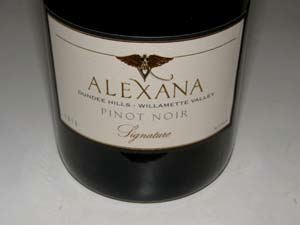 2010 Alexana Signature Dundee Hills Willamette Valley Pinot Noir 13.2% alc., 236 cases, $75. A barrel selection from estate fruit. · Moderately dark reddish-purple color in the glass. Shy nose picking up interest and intensity over time in the glass offering alluring aromas of dark red cherries and berries accented with nutmeg spice. Seamless and soft in the mouth, even creamy, with a full-bodied core of deep red cherry and berry fruits backed by well-integrated oak. Similar to the regular bottling in flavor but more stacked and packed. Remarkable phenolic ripeness and intensity at a relatively low alcohol percentage.
Medical School: Oregon Health and Science University School of Medicine
Dr. VanVolkinburg is a practicing internist in Salem, Oregon, who developed an interest in wine while serving in the United States Air Force in the Mosel Valley in Germany from 1971 to 1974. He spent many hours working in vineyards and cellars. When he finished residency in 1977, he and his spouse Pam looked for a town that needed an internist and had suitable land for growing wine grapes. In 1977, he bought 18 acres south of Salem and planted 1 acre of mostly Riesling since that was the only grape he knew much about. More acreage has been added over time, and as one of the first families to plant a vineyard in the Willamette Valley, the Vitae Springs Vineyard has some of the oldest vines in the region.
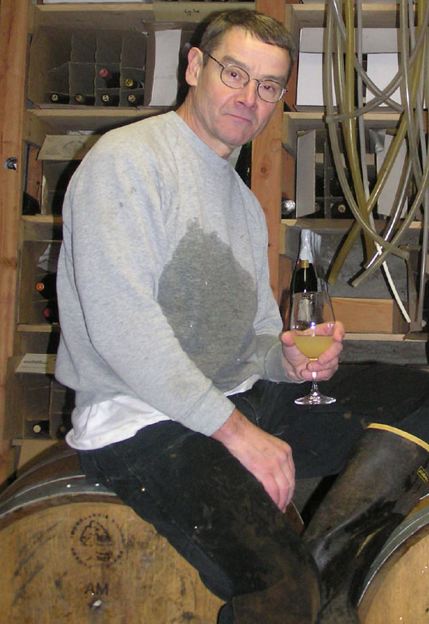 Today, Dr. VanVolkinburg’s son Joel manages the 31 acres of vineyards (25 acres Pinot Noir, 5 acres Pinot Gris, 2.5 acres Riesling and a small amount of Grüner Veltliner) and most of the winemaking chores (Joe Dobbes, Jr., has been a winemaking consultant). Soils are both Jory and Nekia, and clones of Pinot Noir include 667, 777, 115 and Pommard. Small lots of Pinot Noir, Riesling, Grüner Veltliner and Pinot Noir are produced under the Vitae Springs Vineyard label and some vineyard production is sourced by premium wine producers in the Willamette Valley such as St. Innocent. The 2011 Grüner Veltliner is the nation’s first and oldest (30 years) estate grown and produced bottling of Grüner Veltliner. The family’s two car garage doubles as a tasting room. Fewer than 1,000 cases of wine are produced each year. Visit the website at www.vitaesprings.com. Dr. VanVolkinburg likes to quote Paul who wrote to Timothy in Timothy 5:23, “Stop drinking just water, but have a little wine for your stomach’s sake and your infirmities.”
Medical School: University of California at Davis 1993
Dr. Wahle and his parents established a 10-acre vineyard in Yamhill, Oregon, in 1974. This is now considered a “parent” vineyard along with Elk Cove Estate of the Yamhill-Carlton AVA. This became his school agricultural project and required considerable after school and weekend work to establish and maintain the vineyard. Most of the planting material was from the nursery of Charles Coury and included a large planting of the Coury “clone.” When Dr. Wahle attended viticulture meetings with local grape growers, there was no viticulture and enology program available in Oregon for university level study. Dr. Wahle considered programs at Cornell, Geisenheim and Stellenboch, but ultimately found the University of California at Davis program the best fit. He attended the Viticulture and Enology program (Fermentation Science) as a Regents Scholar.
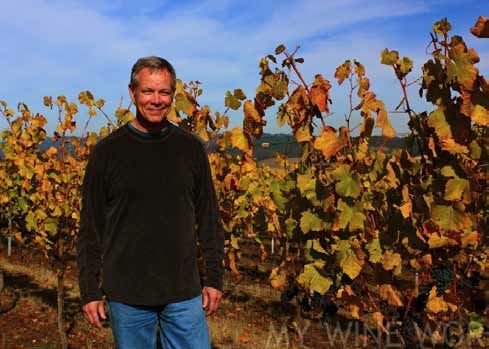 At Davis, the professors suggested caution in Oregon winegrowing attempts, yet they provided an education that prepared him for winemaking in any region of the world. Dr. Wahle gained practical winemaking experience at Chateau St. Jean in California, Chateau Benoit in Oregon and in an exchange program in the Rheinhessen region of Germany. Upon returning to Oregon he discovered that his family transition plan had stalled and this was a life-changing event for him. Unsure of what to do next, he took a break and backpacked with a friend throughout Central America. Experiences on this trip supported an interest in medicine. Growing up in a small farm town in Oregon, he did not have exposure to a medical career path. While attending Davis, many classmates were “pre-med,” and they had encouraged him to take this path. He had essentially completed the “pre-med” curriculum with his earlier fermentation studies and needed only to add a zoology course. Dr. Wahle chose to return to Davis for the medicine program. His Fermentation Science advisor was dismayed that he gave up winemaking, but he reassured her that he ultimately planned to be involved in both careers. He is now a practicing emergency medicine physician in Portland part of the week, and works at his vineyards and winery for the rest of the week. A second vineyard has been established in the Eola-Amity Hills AVA known as Holmes Hill Vineyard. Current production at Wahle Vineyards is 1000+ cases of estate Pinot Noir at Carlton Winemakers Studio while a new winery is completed at the Holmes Hill Vineyard site. This includes production for James Moises, M.D., an emergency medicine colleague in New Orleans. Dr. Moises makes several visits a year to Oregon wine country to participate in grape growing and winemaking. Dr. Wahle also produces wine for Drs. Nicholas and Haydee Bazab, neuroscientists who also live in New Orleans. He has collaborated with them on studies related to the antioxidant properties of Pinot Noir. Dr. Wahle told me the following. “While many see these two career paths as an unusual pairing, I simply remind them of the amazing content overlap that exists. Furthermore, I see the two fields as complimentary in practice. After a stretch of chaotic emergency medicine shifts, it is a relief to shift gears and return to outdoor work in the vineyard. Even with all the scientific advances in enology, there is still room for artistic expression during the winemaking process. After an exhausting harvest season, it also seems ‘balancing’ to return to the hospital to resume work in the fascinating and ever-changing field of medicine.” Wahle Vineyards & Cellars website is www.wvcellars.com.
2007 Wahle Vineyards & Cellars Yamhill-Carlton District Willamette Valley Pinot Noir 13.4% alc., $42. Sourced from the original estate vineyard planting of 1974, one of the oldest vineyards in the Willamette Valley. Willakenzie soils. · Moderately light reddish-purple color in the glass. Aromas of black fruit, pipe tobacco, bark, dark rose petals and a pharmaceutical note. Juicy and smooth on the palate with mid weight flavors of blackberries and black currant backed by sinewy tannins and bright acidity. Good.
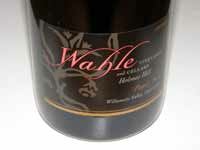 2008 Wahle Vineyards & Cellars Holmes Hill Eola-Amity Hills Willamette Valley Pinot Noir 13.6% alc., $33. Vineyard is named after H.N.V. Holmes who set out from Missouri in search of his land claim in 1848. · Moderately dark reddish-purple color in the glass. Tight initially, opening gradually to reveal aromas of dark berry fruit and subtle oak. Discreetly concentrated flavors of dark berries and plum with hints of graham, chocolate and savory oak. Svelte tannins and balanced acidity. A thoroughly pleasing wine that is nicely balanced. Very good.
2009 Wahle Vineyards & Cellars Willamette Valley Pinot Noir 14.5% alc., $30. Composed of grapes from the older Wahle Estate Yamhill Vineyard and the younger Holmes Hill Vineyard. · Light reddish-purple color in the glass. Aromas of dark red cherries and mocha. A solid wine with pleasing flavors of ripe cherries, spice and herbs, offering very supple tannins, and a juicy, fruity finish. Good.
2009 Wahle Vineyards & Cellars Yamhill-Carlton District Willamette Valley Pinot Noir 14.5% alc., $45. · Light reddish-purple color in the glass. Complex array of scents including black cherry, blackberry, smoky oak and cut grass. Deep, dark cherry and raspberry flavor with impressive intensity and lingering finishing power. The oak is well integrated, the tannins are nicely balanced, and although a big wine, it carries its weight beautifully. Very good.
2009 Wahle Vineyards & Cellars Holmes Hill Eola-Amity Hills Willamette Valley Pinot Noir 13.9% alc., $36. · Light in color with a reddish tone in the glass. The nose offers a sophisticated array of aromas including dark red and black berries, dried herbs including sage, and old book. Very soft in the mouth with vivid flavors of dark red cherries and savory herbs, finishing with some persistence. A nicely balanced wine that aims to please with its easy, approachable charm. Very good.
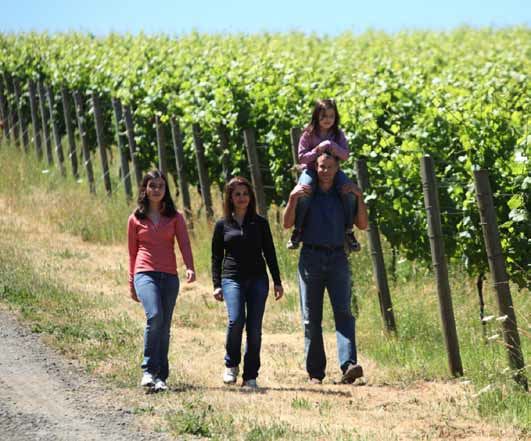
Medical School: University of Hawaii, Manoa, HI 1978
Dr. Zelko comes from a family of doctors. His father was an ophthalmologist and his brother still is. He told me he could remember sitting at the kitchen table with a microscope putting Tennant Mark VIII intraocular lenses in pig’s eyes. His father was always disappointed that he didn’t follow his career path, but at least his brother did. Dr. Zelko moved to Oregon from Denver after he finished training in 1983. What drew him there was Ken Kasey’s Sometimes a Great Notion, perhaps the greatest Oregon book ever written. He quickly met Rachel Starr who owned Great Wine Buys and became enamored of the local wines. He participated in wine tasting courses and brewed beer because at the time there were no microbrews, no one sold quality grapes to amateurs, and F.H. Steinbart Co. Homebrew Supply Shop was close by in Portland. When Rachel and friends started Starr Winery, he and his wife became night time and weekend cellar rats. Eventually they bought a ton or two of Pinot Noir from lesser known vineyards and made their first wine in Linton. This went on from 1992 to 1999 when Starr Winery moved to Newberg. The Zelkos bought 40 acres in the Eola-Amity Hills from a radiologist who thought he could use his 401K money to plant a vineyard. When he was unsuccessful, they took the property in 1995 and started planting it in 1996. The Zelkos preferred the wines from what is now the Eola-Amity Hills AVA because they liked “the gutsy, earthy backbone and black fruit flavors.” The site is situated at 150 to 400 feet with soils ranging from Yamhill to Woodburn. Dr. Zelko was intrigued with the Dijon clones and thought that a blend of multiple clones would yield a more complex and age worthy wine distinctly different from the wines based solelyon Pommard and Wädenswil clones so prevalent in Oregon. He thought that a mixture of earlier ripening clones in a slightly warmer site would favor more years with adequate ripeness and that is what happened. The Z’IVO wines are big and bold, the use of native yeast fermentation has resulted in the complexity he preferred and the wines are maturing well. Dr. Zelko has also made white varietals with purchased grapes and recently planted the “Gouges” clone of Pinot Blanc that Gary Andrus brought to Archery Summit when he made Viriton. 2011 was the first vintage. The winery was initially named Zelko but had to be changed to Z’IVO Wines when Zelko Vodka presented him with a trademark challenge. A month of googling and research came up with a play on Dr. Zelko’s name. His wife, Kathy the lawyer, suggested he put an apostrophe in there to make it fanciful and get it through trademark clearance. In Slovak, ‘zivo’ means vibrant or to be alive as well as Ivo’s. So Z’IVO can be interpreted as Ivo’s wines or wines that are vibrant and alive. Dr. Zelko likes to say Kathy is a wine “fan” and he is more of a “fanatic.”
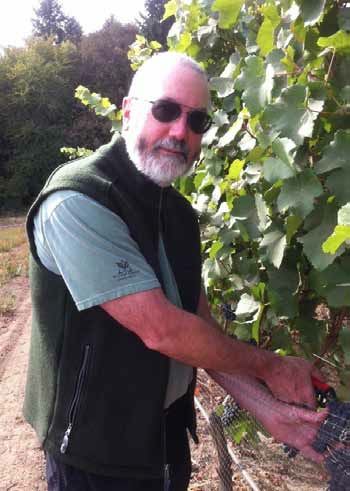 When asked why physicians like to get into grapes and wine Dr. Zelko told me the following. “We have a strong biochemistry background, some disposable income, and the desire to marry art, craft and science in a manner different from the practice of medicine. Grape growers, winemakers and all the farmers, chefs and people passionate about wine and the immediacy of a good life are great people to spend our free time with. Who knows better than us life’s tragedies and sorrows and the need to share what is good.” Z’IVO Pinot Noir is produced entirely from the estate vineyard. Several aromatic white wines are also offered. The wines are handcrafted at Walnut City Wine Works in McMinnville, a small consortium of winemakers who grow their own grapes. The first vintage was 2000. Visit the website at www.zivowines.com.
2007 Z’IVO Eola-Amity Hills Willamette Valley Pinot Noir 14.0% alc., 1,800 cases, $36. Estate vineyard fruit, clones 114, 115, 667, 777 and Pommard. 12 day cold soak, cultured yeasts, 20% whole cluster. Aged in 33% new French oak. · Moderately light reddish-purple color in the glass. Marked sulfur related reduction upon opening which had largely blown off by the following day from an opened bottle. The core of black cherry fruit is juicy and fresh, complimented by a note of wood spice, caressed by supple tannins, and backed by good acidity. Decent.
2008 Z’IVO Eola-Amity Hills Willamette Valley Pinot Noir 14.0% alc., 1,000 cases, $40. All five estate vineyard clones. Ambient yeast fermentation after 1 week cold soak. 20% whole cluster. Aged in 33% new French oak. · Moderate reddish-purple color in the glass. Appealing aromatic profile featuring scents of dark red cherries and berries including ripe strawberries, and spice. Middleweight, slightly confected black cherry core with a hint of brown spices and a subtle riff of salty minerality and oak in the background. Nicely balanced with bright acidity. Good (+).
2008 Z’IVO Whole Cluster Project Eola-Amity Hills Pinot Noir 13.7% alc., 160 cases, $40. From all five estate vineyard clones. Large harvest of 3 tons per acre. 100% whole cluster, barefoot punch downs, ambient yeast fermentation. Aged in 33% new French oak. · Moderately dark reddish-purple color in the glass. Appealing aromas of dark stone and berry fruits, nicely spiced and offering a hint of rose petals. Mid weight, sweet plum and blackberry flavors with firm tannins and a long, long finish. The fruit is striking in intensity and brilliance. Drinkable now, but will benefit from more time in bottle, and should readily age in the cellar. Very good.
2009 Z’IVO Eola-Amity Hills Willamette Valley Pinot Noir 13.4% alc., $N/A. · Light reddish-purple color in the glass. Reduction upon opening which resolves over time. Curiously light in weight for this warm vintage, but not overripe as wines from this vintage in Oregon are prone to be. Flavors of red cherries with complimentary oak in the background, mild tannins, and finishing with a good cut of citrus-driven acidity and notable persistence. Even better the following day from a previously opened and re-corked bottle. Good.
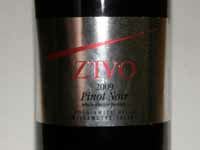 2009 Z’IVO Whole Cluster Project Eola-Amity Hills Pinot Noir 13.4% alc., 138 cases, $40. Clones are 115, Pommard, 114, 667 and 777. 100% whole cluster. Punch downs with bare feet twice a day for seven days. Wild yeast fermentation. Aged 10 months in 25% new, 35% once filled and the remainder neutral French oak barrels. · Moderate reddish-purple color in the glass. This is a wine that attracts your full attention the minute the cork is pulled and all that wonderful Pinot goodness jumps from the glass. I could not get enough of this nose redolent of black cherries, spice and rose petals. On the palate, there is a delicious essence of dark cherries with a spicy touch that really pops. Very silky and charming, with a healthy backbone of fine-grain tannins. A complete and harmonious wine. When whole cluster is right, it produces the most ethereal expression of Pinot Noir in the world. Should get even better with cellaring.
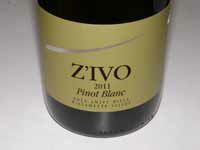 2011 Z’IVO Eola-Amity Hills Willamette Valley Pinot Blanc 12.0% alc., 220 cases, $N/A. Inaugural vintage for this wine. The fruit is a rare spontaneous mutation of Pinot Noir known as the Gouges clone. Vinified in 50% neutral oak and 50% stainless steel. · Very light straw color and clear in the glass. Intriguing aromas of applesauce, apple core, sap and a subtle floral note. Light in weight with bracing lemon-lime acidity, offering flavors of green apples and honey in a crisp, dry French style. Needs food, and I would chill the wine and serve with shellfish, particularly oysters. Good.
Still more “Pinot Noir Doctors.”
Dr. Ackerman graduated from Vanderbilt University School of Medicine in 1988, did his residency in urology at the Oregon Health and Science University and now practices in Clackamas, Oregon. Along with spouse Michelle, he bought and planted in 2007 16 acres of vineyard on the site of a former horse farm in the Ribbon Ridge AVA of the Willamette Valley. The vineyard is just below Ayres and Brick House on Lewis Rogers Lane. Clones are Pommard, Wädenswil, 114, 115, 667 and 777. Grapes were sold beginning with the inaugural 2010 vintage to Ayres, Seven of Hearts Winery and Vincent Wine Company.
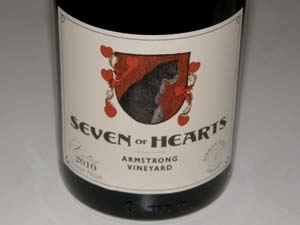 2010 Seven of Hearts Armstrong Vineyard Ribbon Ridge Willamette Valley Pinot Noir 13.5%alc., 98 cases, $35. Released March 15, 2012. Vineyard farmed by owners Dough and Michelle Ackerman. 50% Pommard and 50% 666 with 67% whole cluster fermentation. · Moderately light reddish-purple hue in the glass. Very bright and enticing aromas of fresh berries and rose petals. Big-boned core of purple and black berries and black plum with a subtle oak underpinning. The fruit is overshadowed by the prodigious tannins now, but there is enough fruit presence to grab your attention. More body and fruit than the Lia’s. Needs more time in the cellar, but very promising. Very good (+).
Dr. Bagdade is a graduate of Cornell University Medical School and board certified in internal medicine, endocrinology and metabolism. He formed Pike & Western Wine Merchants at Pike Place Market in Seattle in 1975. He soon wanted to produce world class sparkling wines and by the 1990s had founded Domaine Meriwether. Dr. Bagdade recruited French winemaker Jean-Louis Denois who hailed from Cumieres, just north of Epernay in Champagne. Their first harvest together was 1998. In 2005, Dr. Bagdade returned to his medical calling and Ed Buzz Kawders step in to guide the winery and he enlisted winemaker Raymond Welsh to continue the vision of the winery. Today, the winery produces sparkling wines and still wines including Pinot Noir. The winery is located in Veneta, Oregon, outside of Eugene. The website is www.meriwtherwines.com.
Dr. Koo is a graduate of the medical school at Duke University, a pathologist and neurologist, who is currently a professor at University of California at San Diego School of Medicine who conducts research in the cellular and molecular biology of Alzheimer's Disease and neurodegeneration. He is a popular teacher and renowned researcher with over 125 publications to his credit. Edward and Lin Shen Koo established Temperance Hill Vineyard in 1980 and 1981. It is 100 acres made up of about 20 different blocks on a 200-acre site in the west Eola Hills, just west of Salem, Oregon. 80% of the vineyard is planted to Pinot Noir with lesser amounts of Chardonnay, Gewüztraminer and Pinot Gris. Dai Crisp has managed the vineyard since 1999 in accordance with Oregon Tilth Organic Certification standards. Grapes are sold to twenty clients, including such notable wineries as Adelsheim, Bergström, Chehalem, Elk Cove, Evesham Wood, Lange, Panther Creek and St. Innocent.
Noble Pig Winery was founded in 2008 by winemaker Cathy Pollack and her physician spouse, Henry Pollack, M.D.. The couple spent most of their life in Southern California where Henry had a successful obstetrics and gynecoloogy practice until health problems cut his career short. They moved to Davis, California, where Cathy enrolled in the school’s Viticulture and Enology Program. During her schooling, Dr. Pollack was diagnosed with Parkinson’s Disease. The Pollacks found a home in the McMinnville AVA where they bought 88 acres and planted their first 4 acres of Pinot Noir in 2010 (Pommard, 777 and 115). They plan to source grapes initially and gradually increase production to 5,000 cases. The website is www.noblepigwinery.com.
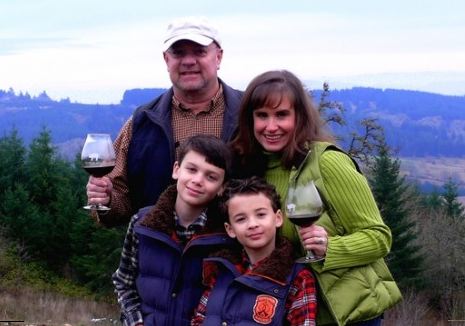
Pinot BriefsAnnual Passport to Pinot Weekend Sponsored by the Russian River Valley Winegrowers (RRVW), this event will take place June 8 & 9 from 11:00 AM to 4:00 PM. More than 30 wineries will participate. This link provides specific information about the weekend events: www.rrrvw.org/passport-to-pinot/. This year’s event programming will be greatly expanded in 2014 as the Pinot Classic will debut June 12 to 15, 2014, offering winemaker dinners and receptions; barrel, vertical and library tastings; private and public winery tours; and a grand barrel auction and dinner.
 West of West Wine Festival This pinotcentric event will be held August 2, 3 and 4 in Sebastopol and will feature over 40 participating West Sonoma County wineries. Welcome dinners Friday night, August 2, Saturday morning seminars and the first of two Grand Tastings on Saturday afternoon, August 3, and a repeat of the Grand Tasting on Sunday afternoon, August 4, following morning vineyard tours. West of West (WOW is sponsored by West Sonoma County Vintners (WSCV), an association of wineries who farm wine grapes on the coastline of Sonoma County. For information and tickets, visit www.westsonomacoast.com. This will sell out! (The event will be held in downtown Sebastopol at the new Barlow conference center. There are two hotels within walking distance: Fairfield Inn & Suites is about 1.5 miles away and Sebastopol Inn is across the street)
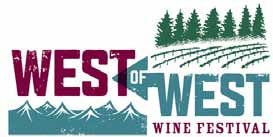 9th Annual Pinot Days San Francisco Grand Festival Public Tasting A very large gathering of Pinot Noir producers, primarily from California, on Sunday, June 30 at Festival Pavilion, Fort Mason, San Francisco. Three seminars are offered on Saturday, June 29, including “A Sojourn Through The Many Styles of Northern California Appellations,” “Celebrated Vineyards: Keefer Ranch, Pisoni, Bien Nacido and Gap’s Crown,” and “Jean Charles Boisset Focus Tasting.” Tastings are also scheduled at various area retailers the week before the Grand Festival. For tickets visit www.pinotdays.com. Pali Wine Co. Secures Long Term Lease on Huber Vineyard in Sta. Rita Hills The Huber Vineyard was first planted by Norman and Traudl Huber in 1987-88, making it one of the oldest vineyards in the Sta. Rita Hills AVA. The vineyard is planted to 8 acres of Pinot Noir clone 115 and 3 acres of Pinot Noir clone 667. There is also 11 acres of Wente clone Chardonnay. Pali plans to produce a vineyarddesignate Pinot Noir and Chardonnay from the property as well as include some fruit for the Summit Sta. Rita Hills appellation bottling. The Huber family will continue to produce Dornfelder from the 1.5 acres planted on the property. C. Donatiello Winery Grand Opening Celebration C. Donatiello, the winery formerly located on Westside Road and a producer of ultra premium Pinot Noir and Chardonnay, has re emerged and is opening a new tasting room at 320 Center Street in Healdsburg. Visit www.cdonatiello.com.
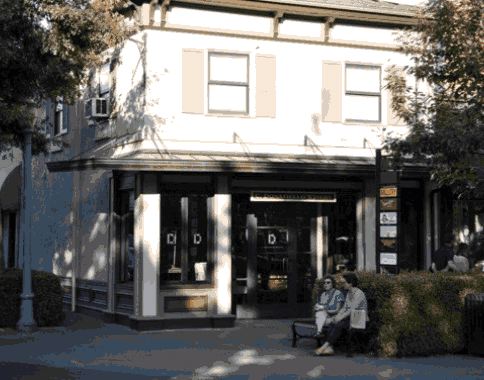 Oregon’s Oldest Estate Winery Awarded Historical Status HillCrest Winery and Distillery, the birthplace of Oregon Pinot Noir, was awarded historical status by Oregon Travel Experience and a state marker will be place at the winery to commemorate the first planting of Pinot Noir grapes in the state in 1961. HillCrest was established by Richard Sommer, the “Father of Oregon Wine,” and co-founder of the Oregon Wine Board. Under his leadership, HillCrest was the first winery in America to use stainless steel tanks. The current proprietor is Dyson DeMara who produces 1,400 cases annually from Oregon’s oldest dry farmed hillside vineyards. For more information, visit www.hillcrestvineyard.com. Sideways Author Rex Pickett Releases a Pinot Noir Rex Pickett has released the 2011 Ne Plus Ultra Willamette Valley Pinot Noir. The wine is produced from grapes grown at Twelve Oaks Estate Vineyard in the Chehalem Mountains AVA and crafted by the winemaking team of Drew Voit and Darcy Pendergrass. Quigley Fine Wines helped to fund the project and offer the wine for sale. Total production was 195 cases ($45). Pickett is currently working on a third novel in the Sideways series to be set in Chile. He is also hoping to have a film sequel based on his second novel Vertical. According to Decanter.com (May 22, 2013), Pickett is also pushing to get Sideways The Play on Broadway. After a successful run at the Ruskin Group Theater in Santa Monica last year, the play will open at the La Jolla Playhouse near San Diego in mid- July and is expected to run for five weeks. Tony-award winning director Des McAnuff (Jersey Boys) will direct at La Jolla.
 New Winemaker at ROAR Wines Gary Franscioni has announced that with the 2013 vintage, Scott Shapely will take the winemaking reigns from Ed Kurtzman. Kurtzman left to devote more time to his own wine labels and successful consulting business. ROAR will now have a full time, in house winemaker. Shapely has worked side-by-side with Ed over the past year and Adam Lee will continue to consult. Hanzell Vineyards to Introduce New Single Vineyard Selections Sixty years after the first grapevines were planted on the Hanzell estate, this producer introduces the first in a series of new Estate Single Vineyard wines. These very limited, small production wines will provide a snapshot of specific blocks of the winery’s 46 planted acres. The 2010o Hanzell Pinot Noir, Sessions Vineyard ($95) celebrates Winemaker Emeritus Bob sessions. Only 99 cases of this wine were produced. The 4.5-acre Sessions Vineyard was planted in 1999 and features unique rootstock and scion combinations. Two additional Estate Single Vineyard wines will be released later this fall: 2011 Hanzell Chardonnay, de Brye Vineyard and 2011 Hanzell Chardonnay, Ambassador’s 1953 Vineyard. In 2014, the winery will introduce wines from two other vineyards, Ramos and Day. Tasting notes for the Sessions Vineyard Pinot Noir can be found on Hanzell Vineyards’ new website which includes one of the most in-depth tasting note archives of Hanzell wines publicly available, allowing a search of vintages dating back to 1967. German Pinot Road Tour 2013 German Pinot Noirs are in a break out mode and this insider tour will include sessions with top German Pinot Noir winemakers, cultural and historical highlights, artisan food and regional cuisine. Taste your way through Franconia, the Rhine area, the Palatinate, Black Forest and Baden. The German Pinot Road Tour includes 8 nights and 9 days, private visits to more than 17 top Pinot Noir estates including Ziereisen, Salwey, Gutzler, Becker, and Thoerle Estate. A special workshop and tasting will be conducted by David Schildknecht, German wine specialist for Robert Parker’s Wine Advocate. For more information call +1 215 991 9892, visit www.treasuresofeuropetours.com or email info@treasureofeuropetours.com. The photo below is of Christoph and Johannes Thoerle of Thoerle Estate in Rheinhessen.
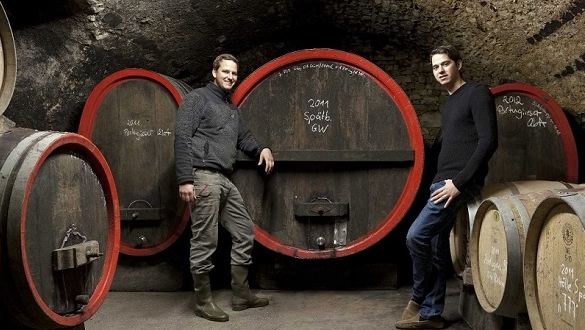 Watering Back Alcohol Levels One of the worst kept secrets in winemaking is the often used practice of adding water to reduce alcohol percentages of wines in which grapes are picked at high Brix levels. Consumers consider this practice an inferior form of winemaking. The Drinks Business (May 17, 2013) reported that French winemaker Michel Chapoutier is concerned with rising alcohol levels caused by increasing CO2 levels. To solve this problem he proposed several solutions but was most emphatic about adding water to achieve lower alcohol levels without diluting the flavor. He found that in tests he conducted, wine with water added was preferred of all the samples. Proposal to Reduce Legal Driving Limit to 0.05% BAC The National Transportation Safety Board (NTSB)has proposed lowering the legal limit for BAC while driving to 0.05%. Many groups have been outspoken opponents of this proposal despite the NTSB’s assertion that a driver with a BAC of 0.05% is more likely to be in an automobile crash than a driver who has consumed no alcohol. A driver with the current liomit BAC of 0.08% (0.04% for commercial vehicle drivers) is 169% more likely to have an automobile accident than a sober driver. Currently, more than 100 countries have limits at or below 0.05%. According to the California DMV table that accompanies car registration renewals, lowering the BAC limit to 0.05% would essentially limit drivers to one standard drink, especially if they weight less than 140 pounds for women and 100 pounds for men and two standard drinks would put both men and women at high risk for exceeding the limit. Jackson Family Wines Buys Zena West Vineyard K-J continues to buy up Oregon vineyard land. The 41-acre Zena West Vineyard in the Eola-Amity Hills AVA is the latest acquisition. Zena West Vineyard is adjacent Zena East and Zena Middle estates, which the company bought in March 2013. The three vineyards together are known as Zena Crown and consist of 80 acres of vines. K-J has also bought a 200-acre vineyard known as Gran Moraine in the Yamhill-Carlton district of Oregon. K-J plans to produce premium Pinot Noir from these vineyards. The acquisitions are a stunning change in the Willamette Valley where there has been little large corporate vineyard ownership. NW Wine Co. Acquires Nearly 400 Acres NW Wine Co. bought two Willamette Valley Vineyards for $3.87 million. The Wildewood and Domaine Loubejac vineyards near Monmouth include 385 acres of Pinot Noir and Pinot Gris. NW Wine Co. already manages 185 acres near McMinnville and has a 45,000-square-foot winery and 15-acre vineyard at its Dundee home. NW Wine Co. becomes number two in the state for ownership of planted vineyards behind Duck Pond. Laurent Montalieu is NW Wine Co.’s winemaker and managing partner. Montalieu said that the acquisition was needed to guarantee a supply of grapes needed to supply the custom labels made for restaurants, retailers and distributors in the United States. Valley Fever Cases Rises in Southwest Valley fever, or coccidioidomycosis is a fungus disease that affects an estimated 150,000 people nationwide, particularly in parts of California and Arizona. There is no vaccine or curative treatment. Current anti-fungal medication has marked side effects. The fungal spores live in the soil and can be inhaled into the lungs and can spread to other parts of the body. The Centers for Disease Control and Prevention reports the total number of valley fever cases nationwide rose by 900 percent from 1998 to 2011. Workers in vineyards and winemakers are at higher risk. Todd Schaefer, a winemaker in Paso Robles, California is one of those who became sick after running a bulldozer. He has been taking antifungal medication for years but his health is faltering as he continues to produce Pinot Noir and other wines at Pacific Coast Vineyards. Visit www.npr.org/blogs/health/2013/05/13/181880987/cases-of-mysterious-valleyfever- rise-in-american-southwest?sc=ipad&f=1001. CA Vintner Gives $25 Million plus New Wine to Univ of New Hampshire Each member of the inaugural graduating class of the Peter T. Paul College of Business and Economics at the University of New Hampshire will receive a bottle of 2011 Peter Paul Russian River Valley Pinot Noir with their diplomas. The wine, made by California vintner and university alumnus Peter Paul, carries the designation, “Live Free or die,” a phrase best known as the New Hampshire State motto and first uttered by Revolutionary War hero General John Stark. Mr. Paul gave a $25 million challenge grant to his alma mater in 2008 to build the new business college. 500 cases of the wine are available for sale at www.peterpaulwines.com.
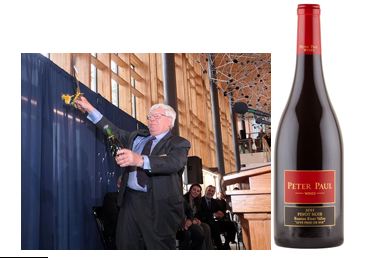 New Zealand Vintage 2013 a Winner Vintage 2013 is predicted to be one of the best in history for New Zealand wine. Across the entire country, the summer of 2013 offered weeks of sunshine, warm temperatures and a lack of rain. Central Otago experienced a late frost in November which reduced yields by 10% to 15%, but the summer provided long, warm days and kept the vineyards disease free. Tony Bish, winemaker at Sacred Hill, said, “It’s a dream vintage. The fruit is early, ripe, clean; everything we would want.” Talbott Vineyards Opens New Carmel Valley Tasting Room Located at the corner of Pilot Road and Del Fino Place in Carmel Valley Village, the new 2,800-square-foot Talbott Vineyards Tasting Room will also serve as a museum for founder Robb Talbott’s unique collection of vintage motorcycles and pedal cars. The new location replaces Talbott’s former Carmel Valley Tasting Room, and features an expansive tasting bar and a private Diamond T Room for special gatherings. The site also has a picturesque patio with outdoor seating and bocce ball courts. Photographs detailing the story of winegrowing and winemaking at Talbott Vineyards adorn the walls of the tasting room. Before founding Talbott Vineyards in 1982, Robb Talbott raced motorcycles and had a business restoring and selling antique cars and trucks. The tasting room is open daily from 11:00 AM to 5:00 PM and standard and premium tasting experiences are offered for a nominal charge. Talbott Vineyards also has a Tasting Room at its winery at 1380 River Road in Salinas, which is open Thursday through Monday from 11:00 AM to 4:30 PM. Visit the website at www.talbottvineyards.com.
 The Eyrie Vineyards Opens Its Library Michael Alberty of Storyteller Wine Company in Portland is always in tune with the latest happenings in the Willamette Valley. He reported recently about the “mythical status of the Eyrie library that is a treasure trove of history and few have ever laid eyes upon the entire collection.” Apparently David Lett, the founder of The Eyrie Vineyards, liked to put aside in his library cases of many wines he made, particularly those he liked. In fact, the more he liked a wine, the more of it he kept back (without telling his spouse). For example, the library contains over three decades of South Block Reserve Pinot Noir kept in perfect cool, dark storage and never made available for sale. When David passed away, there were remarkably about 6,000 cases of library wines in storage. When Jason Lett decided to start releasing wines from the library, he was intent that the wines be pristine so a inspected and re-bottled every bottle so the purchaser is guaranteed there is no cork related issues. Alberty is offering the 1992 The Eyrie Vineyards Estate Pinot Gris ($80), the 1993 The Eyrie Vineyards Estate Chardonnay ($130), the 1995 The Eyrie Vineyards Reserve Chardonnay ($150), the 1993 The Eyrie Vineyards Pinot Meunier ($160), the 1986 The Eyrie Vineyards Estate Pinot Noir ($195), the 1999 The Eyrie Vineyards South Block Reserve Pinot Noir ($220), and the 1983 The Eyrie Vineyards South Block Reserve Pinot Noir ($400). These are spectacular special occasion wines. Inquire at 503-206-7029 or email through the website at www.storytellerwine.com. eMagazine for French Wine Explorers A resource to all things related to France and French wine. This online magazine details timely travel tips and alerts, French wine reviews and articles, and wine touring information all in bite size portions to quickly gain deep knowledge of the food, wine and culture of France. Subscribe at www.wine-tours-france.com. Pinot & Pizza at J Vineyards On Saturday, June 29, renowned chef and author Andrea Mugnaini will cook an array of wood-fired pizzas, paired with J’s Russian River Valley Pinot Noirs and other wines and served on J’s scenic terrace. Chef Mugnaini runs two cooking schools dedicated to wood fired cooking; one in Healdsburg and the other in Tuscany. Buy tickets ($70 per person, $55 for wine club members) online at www.jwine.com. Relation of Alcohol Intake to Risk of Dying from Cancer A new meta-analysis published in the Annals of Oncology looked at more than 48,000 cancer deaths reported in 18 prospective cohort studies. This is the first meta-analysis to explore the relationship between alcohol drinking and risk of all cancer mortality. The analyses demonstrated a J-shaped curve for alcohol and cancer. Light drinkers showed a statistically significant 9% lower risk, moderate drinkers showed no effect, and heavier drinkers shoed a 32% increased risk of all cancer mortality. It is important that the only significant risk in cancer mortality among the almost 50,000 cancer deaths was for consumers of 50 grams or more of alcohol per day (about 3.5 standard drinks of wine). The findings do not support the often publicized statement that any amount of alcohol increases the overall risk of dying from cancer confirming that wine in moderation is part of a healthy lifestyle. Marcassin Will Not Release 2008 Vintage Pinot Noirs Because of smoke taint resulting from wildfires in the Anderson Valley during the 2008 vintage, Marcassin announced in their latest letter to mailing list members that they will not release 2008 Pinot Noirs. Although analysis of the wines shows that they are within acceptable limits for smoke taint, they do not meet the high standards of Marcassin. Bacchus Capital Management Buys Panther Creek The private equity firm, Bacchus Capital Management, has bought Oregon’s Panther Creek Winery from owner Liz Chambers and her family for an undisclosed sum and have hired noted winemaker Tony Rynders to take over the reigns according to WineSpectator.com (May 15, 2013). Ken Wright founded Panther Creek in 1986 and sold the winery in the early 1990s when he founded Ken Wright Cellars. The Chambers family bought it in 2005. Chambers retained the winery in McMinnville and plans to launch a new label, Elizabeth Chambers Cellars with Michael Stevenson as the winemaker. Bacchus Capital Management is also buying a stake in Washington-based DeLille Cellars. The “Serve a Minor” Felony Bill AB 1128 is currently on a fast track to pass through the California legislature. This bill amends Business & Professions Code Sec. 25658 and increases the penalty for sales to a minor from a misdemeanor to a felony when the minor causes an injury, damage or death to others. If a winery serves a customer in their tasting room who is younger than 21, and that person later gets into an accident or commits a crime like assault where alcohol is a factor, the winery will end up with a felony which bars them from the wine industry by revoking their license for at least a decade. Basically, AB 1128 is a death penalty for individual and corporate alcoholic beverage licensees. Many youths under age 21 have good false identification, but when they get caught driving drunk or in an accident, they ditch their fake ID and show their real identification. It becomes their word against the word of the winery. Winery Closures & Sales Anderson Valley Pinot Noir specialist Londer Vineyards is closing after 12 years. Larry and Shirlee Londer sold their vineyards in 2011 and relocated to Colorado to be close to their family. They continued to make wines and support the brand, but eventually decided to exit the business at the end of May. Gary Farrell parted ways with Alysian as of April 30 for personal reasons. He plans to take a harvest off and travel extensively and actively buy and sell collector cars at auctions throughout the country (something he has done as a hobby for years). Also in Anderson Valley, the Klindts have sold Claudia Springs Winery, and Elke’s Donnelly Creek Vineyard and the Esterlina Estate vineyard and winery are for sale. Evening Land Vineyards Property in Sta. Rita Hills Sold Sommelier Rajat Parr and winemaker Sashi Moorman have bought an extreme site 6.5-acre vineyard in the Sta. Rita Hills owned by Evening Land Vineyards that is planted to Pinot Noir and Chardonnay and an adjacent 6.5 acres of plantable land. One of the vineyards is Memorious, planted to Pinot Noir from seeds and on its own rootstock. The new project will be called Domaine de la Côte. Normacorc Introduces First Zero Carbon Footprint Closure Normacorc has introduced Select® Bio, a closure made with plant-based polymers from sugar cane. The wine closure is meant for sustainable wineries and their wines. Select® Bio is 100 percent recyclable and made using renewable materials. The closure can control oxygen ingress (several different oxygen ingress levels are offered), reducing wine’s susceptibility to spoilage due to oxygen mismanagement and improve post-bottle aging and bottle-to-bottle consistency. New Blog for Winemaker Adam Lee Adam Lee has launched a new blog at www.adamleesiduri.blogspot.com/ to share his thoughts about Siduri and Novy wines, wine in general, and whatever else crosses his mind. Adam told me he wanted to be a wine writer so this gives him an outlet. Wine Additive to Counteract Sulfites Miles and Christina Clifford of New Zealand have released UBFree that eliminates free sulfites in wine and thereby allowing people with sulfite allergies to enjoy wine without side effects. UBFree eliminates most free sulfites in wine and introduces a mineral to assist the body in processing the rest. UBFree comes in a dropper bottle or a sachet. The additive does not change the flavor of wine unlike other similar products that have been developed in the past. Available online at www.ubfreewine.com. Eating and Drinking Well in Sonoma County Wine Country I recently spent ten days in Sonoma County and there are two restaurants in particular that stood out. One is Diavola in Geyserville, about a 15 minute drive from Healdsburg. Brick walls, very casual, outstanding servers, solid wine list, and great innovative Italian food including wood fired oven pizzas. No reservations so arrive early. The second is Glen Ellen Star in Glen Ellen, Sonoma Valley. Tiny, but comfortable, especially the patio. Veggies are the center of attention here and everything is meant for sharing. Outstanding wine list. Best wines I drank over the 10 days? 1997 Williams Selyem Rochioli Vineyard Pinot Noir (magnum), 1991 Williams Selyem Summa Vineyard Pinot Noir (magnum) (both wines enjoyed from Burt Williams’ cellar and graciously shared by him), and 2009 Morning Dew Ranch Jan’s Cuvée Anderson Valley Pinot Noir (Burt’s last wine). In my opinion there has never been a California Pinot Noir winemaker the equal of Burt Williams.
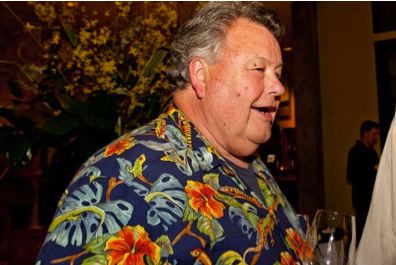 Voluntary Nutrient Content Statements. TTB Ruling 2004-a, issued May 28, 2013, authorizes “truthful, accurate, and specific voluntary statements about nutrient content, including calorie and carbohydrate content, in the labeling and advertising of wines, distilled spirits, and malt beverages.” Labeling or advertising representations that mislead the consumer about the nutritional value or health effects of alcohol beverages are prohibited. This is an interim policy while rulemaking is completed. View the ruling at www.ttb.gov/rulings/ 2013-2.pdf. World’s First Smartphone Breathalyzer, BACtrack Mobile™ I believe this will become very popular among wine drinkers who dine out frequently as it is a reliable way of measuring BAC with an iPhone. The breathalyzer unit connects to an iPhone wirelessly via Bluetooth and quickly estimates your BAC using an accurate professional-grade alcohol sensor. The BACtrack can save results and estimate when the BAC will return to 0.00%. It also has sharing capabilities. Price is $149.99, significantly cheaper than a DUI. Visit www.bactrack.com. Floome™ Personal Breathalyzer device works with Smartphone to Measure BAC This device plugs into your smartphone to tell you if you have had too much and how long you need to wait to get behind the wheel. This product was just launched by 2045Tech and the makers say it is the first portable personal breathalyzer to incorporate the same sensors that the policemen use. The user blowers into the device which connects to a smartphone via the headphone jack. An app then displays the blood alcohol content. It can also call a taxi. Floome is selling now via an Indiegogo Flexible Funding campaign for $65 and will be $80 when it is released to retail this fall. Visit www.2045tech.com. Wireless Breathalyzer for Remote Alcohol Monitoring SOBERLINK, Inc., is a technology company based in Southern California that has developed a wireless breathalyzer much sought after by parents of college-aged students. Binge drinking is on the rise with more than 50% of college students affirming that they drink excessively within any given two-week time period. SOBERLINK's handheld device monitors sobriety by sending breathalyzer results to a cloud-based website for review, increasing safety among college-aged students and providing peace of mind for their parents. The SOBERLINK device has a built-in camera for user verification and cellular module for wireless transmission. Visit www.soberlink.net to learn more. Urban Wine Xperience The 8th Annual Urban Wine Xperience, sponsored by the East Bay Vintners’ Alliance (EBVA), will be held on Saturday, July 27 at Oakland’s Jack London Pavilion. Over 15 urban wineries from the EBVA will pour a wide variety of wines and local eateries and food purveyors will create bites to pair with the wines. Guests can enjoy the outdoors and dance to live music. Noted Pinot Noir producers include Aubin Cellars and Stomping Girl Wines among others. Early bird tickets until June 26 are only $35, $45 after that date. For tickets, visit www.brownpapertickets.com/event/385762. Mueller Tasting Room Opens Mueller Winery will open the doors to its new tasting room on Saturday, June 1, at 118 North Street across from the Raven Performing Arts Center in Healdsburg. Mueller, founded by Robert Mueller, is a top producer of Pinot Noir. Emily’s Cuvee is the flagship wine, first produced from the 1994 vintage. Why I Love Oregon Pinot Noir Contest Willamette Valley Vineyards is sponsoring a contest for Pinot Noir enthusiasts to share their experience about when, where or how they fell in love with Oregon Pinot Noir. Now in its ninth year, the contest's winner will win an all-expense paid trip to Oregon Wine Country and Willamette Valley Vineyards valued at $4,000. Submissions are accepted now through July 31, 2013 and can include a short essay, photo, artwork or video. Visit www.wvv.com/contest for the official rules to enter the contest. Winners will be announced August 9 at www.wvv.com. |